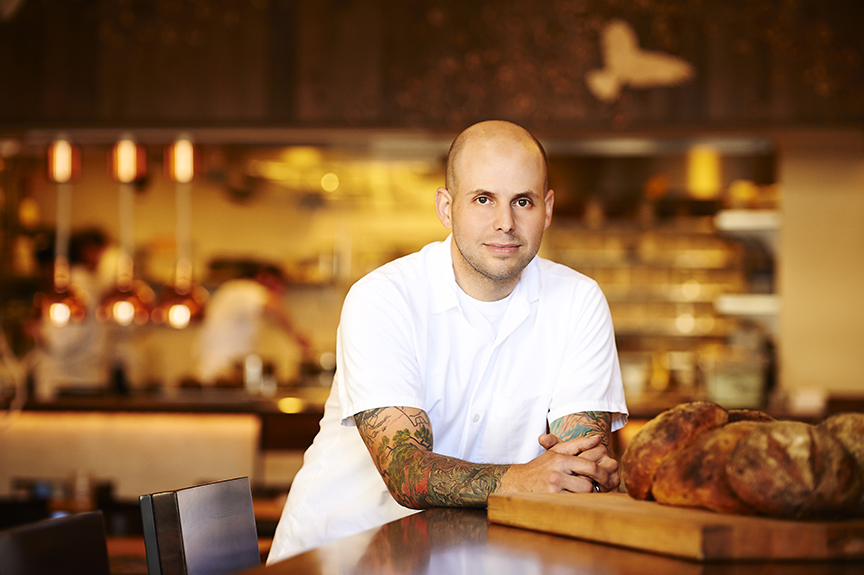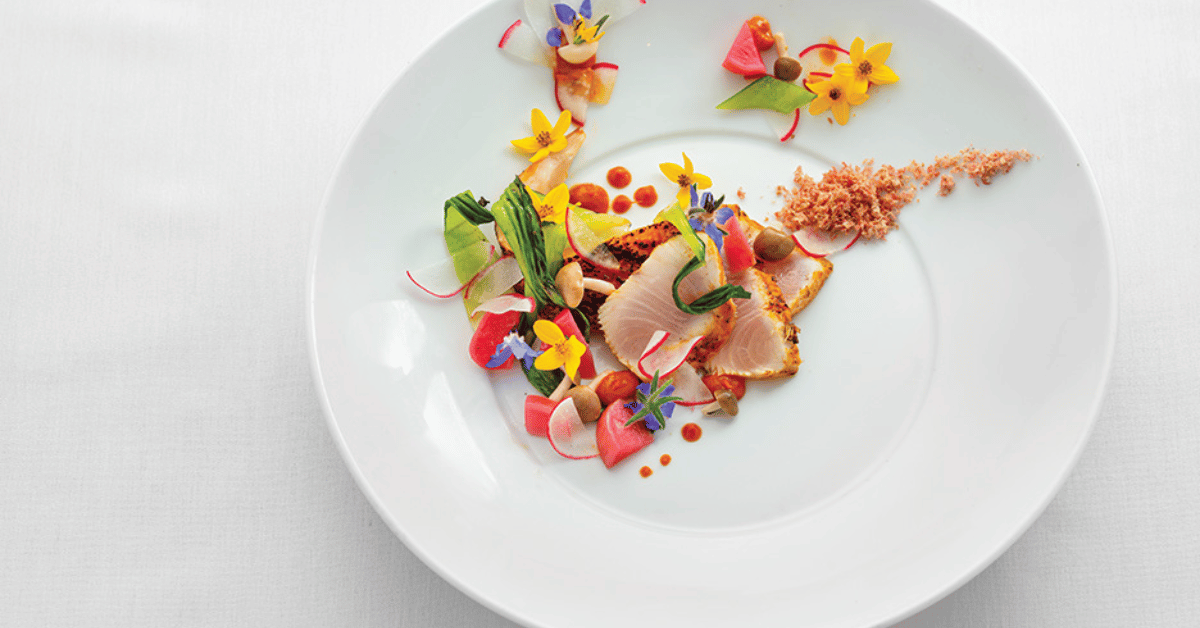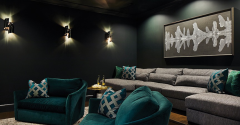
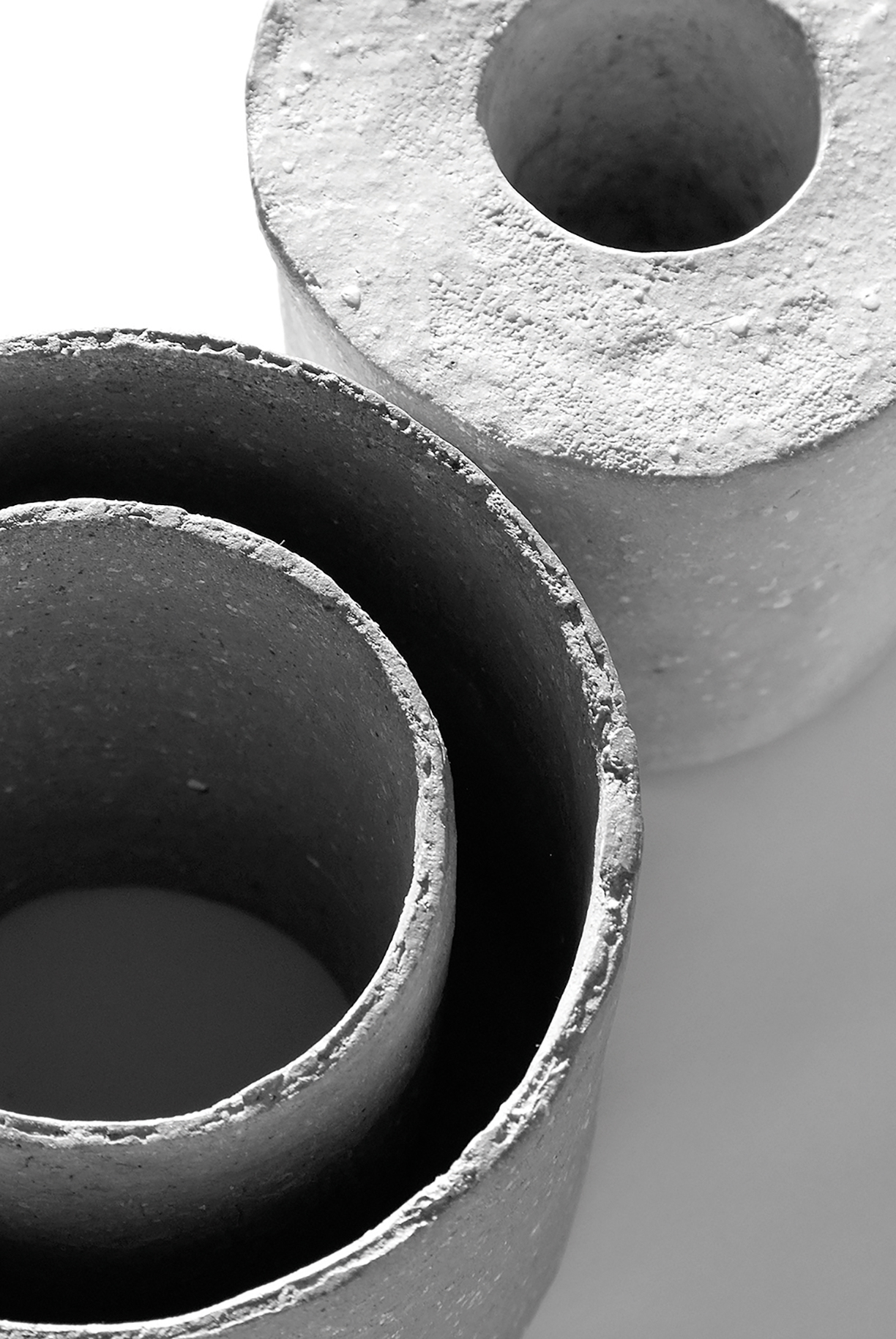

PHOTOS FROM WABI-SABI: FURTHER THOUGHTS BY LEONARD KOREN
The ancient Japanese design philosophy of Wabi-Sabi turns “the not-beautiful into the beautiful.”
What happens when a new design trend highlights the beauty of imperfections?
The aesthetic of wabi-sabi was originally related to the traditional Japanese tea ceremony, but has since been developed into a design style, highlighting all things “opposite of perfect.” Unique and striking by nature, this style derives from a deep understanding and respect for time and recognizing the beauty in the understated.
Author Leonard Koren describes this distinctive philosophy in multiple ways, from the “antithesis of the Classic Western aesthetic notion of beauty,” to the “beauty of things imperfect, impermanent, and incomplete; of things modest and humble; of things unconventional.” Before writing two books on wabi-sabi, Koren first learned the term during his youth in the 1960s. As he describes in his book Wabi-Sabi for Artists, Designers, Poets & Philosophers, to him the term initially seemed to be “a nature-based aesthetic paradigm … a perfect antidote to the pervasively slick … corporate style of beauty that I felt was desensitizing American society.”
Koren notes that when physically manifested, wabi-sabi is related to the “entropic processes that all living things are subject to,” meaning that it embraces the method of showing objects that are worn or time-weathered. Antiques, for example, are generally imbued with qualities of wabi-sabi, Koren says. “An 18th century Italian desk, for instance will have evidence of hundreds of years of human use and misuse — along with the discoloration and natural deterioration that comes with age.” Further, he reminds us that despite its appearance, the character and merit of the desk “is not diminished by these ‘imperfections.’”
Another aspect that Koren stresses is that wabi-sabi art or design pieces are often initially perceived as ugly. “It is the transmutation of the not-beautiful into the beautiful that is part of the magic of wabi-sabi,” he affirms. He adds that every person perceives this aesthetic in different ways and applies it where they think it best. Though not as well known as styles like Modern or Contemporary just yet, designers and artists are appreciating the freedom and creative liberties of wabi-sabi and are finding ways to apply it in various ways.
Passionate about Japanese culture for over 10 years, Ukranian designer Sergey Makhno calls himself a devotee of minimalism and wabi-sabi, calling it a “manifesto of nature and tradition, simplicity [and] tranquility.” Makhno, like Koren, relates the philosophy to the impermanence and imperfections of man, asking that if man is imperfect, why should the place he calls home be perfect? As the founder of Makhno Studio, Makhno works on a multitude of projects, but his first venture in applying wabi-sabi principles into a physical space was in his own home.
“I had to make sure that the design philosophy was practical,” he says, and from its first installation it was a success. The project, titled Wabi-Sabi Apartment, has won multiple interior design competitions and showcases qualities that Makhno chose to highlight: honoring nature, remembering history, loving art and showing courage.
From the moment you walk in, the Wabi-Sabi Apartment boasts a carefully designed interior that is in stark contrast with the concrete cityscape outside. The walls are finished with clay, in a technique seen in older Ukrainian homes, while the wooden beams that support the ceiling and doorways are left looking rough and rustic. Nature is also represented in bonsai trees and a small roof garden.

PHOTO FROM WABI-SABI: FOR ARTISTS, DESIGNERS, POETS & PHILOSOPHERS BY LEONARD KOREN
Much of the furniture and art also display the aesthetic in simple yet functional ways. For example, the metal lampshades hanging in the home help integrate a contemporary element to the overall earthy, natural interior. “Their own imperfections also demonstrate how the ancient philosophy of wabi-sabi can find new applications in contemporary design, making us appreciate the beauty of handmade objects through the use of natural materials,” according to Makhno Studio.
Makhno says wabi-sabi provides simple principles that anyone can follow. From the use of natural materials that show signs of wear, as well as colors that tie closely to the earth, to incorporating nature itself, Makhno stresses that “things live with and for the person; a person does not live for the sake of things.”
Another design choice Makhno mentions is the incorporation of kintsugi pieces, or kintsukuroi, which roughly translates into “golden joinery.” These pieces are created through the traditional Japanese practice that joins broken fragments of ceramics together with gold, which according to ceramic artist Tomomi Kamoshita is viewed almost as a reincarnation of the original object. “When cherished pieces are broken, we save them and transform them into keshiki (the restored piece),” she says, giving the ceramic a “new life.”
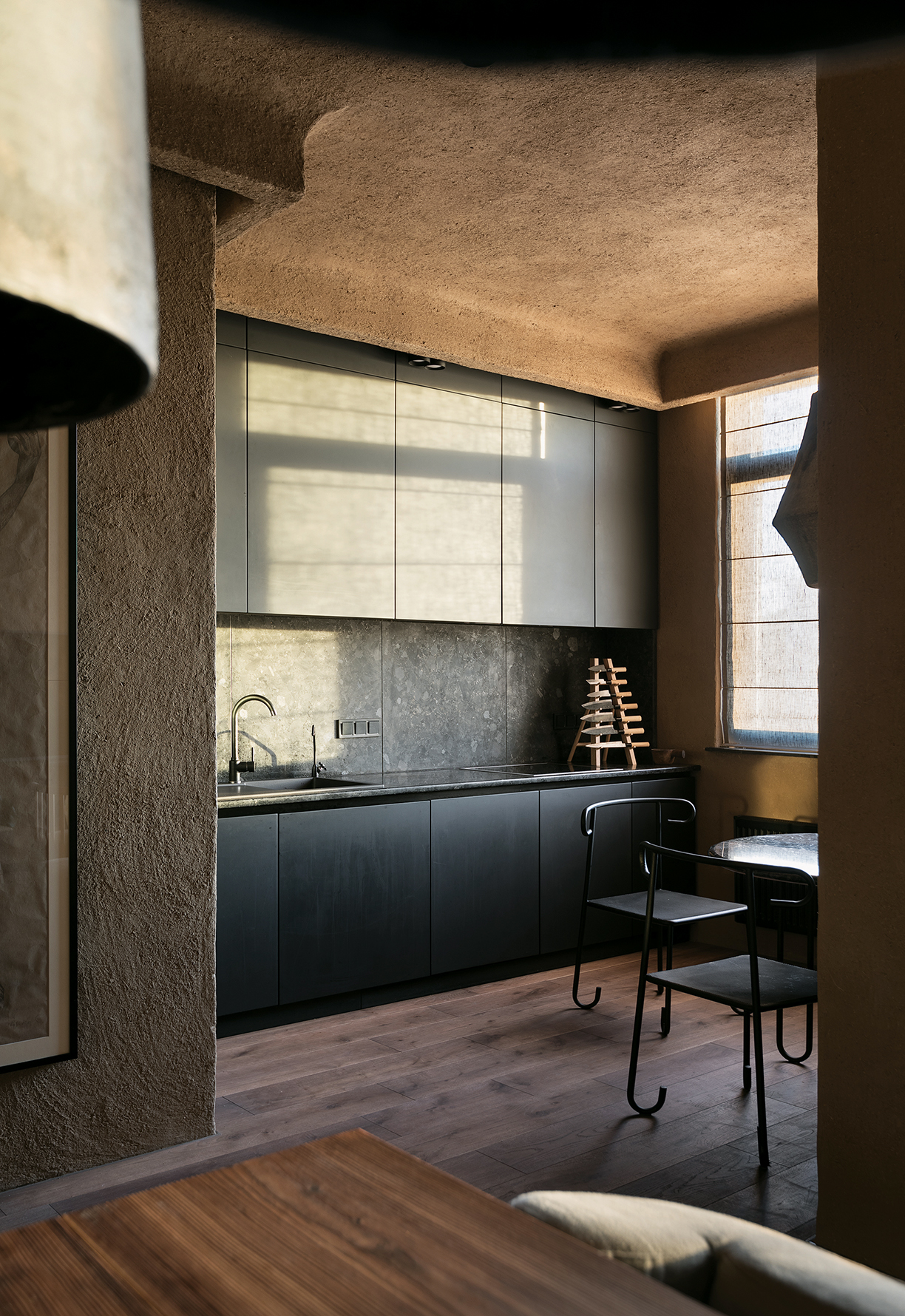
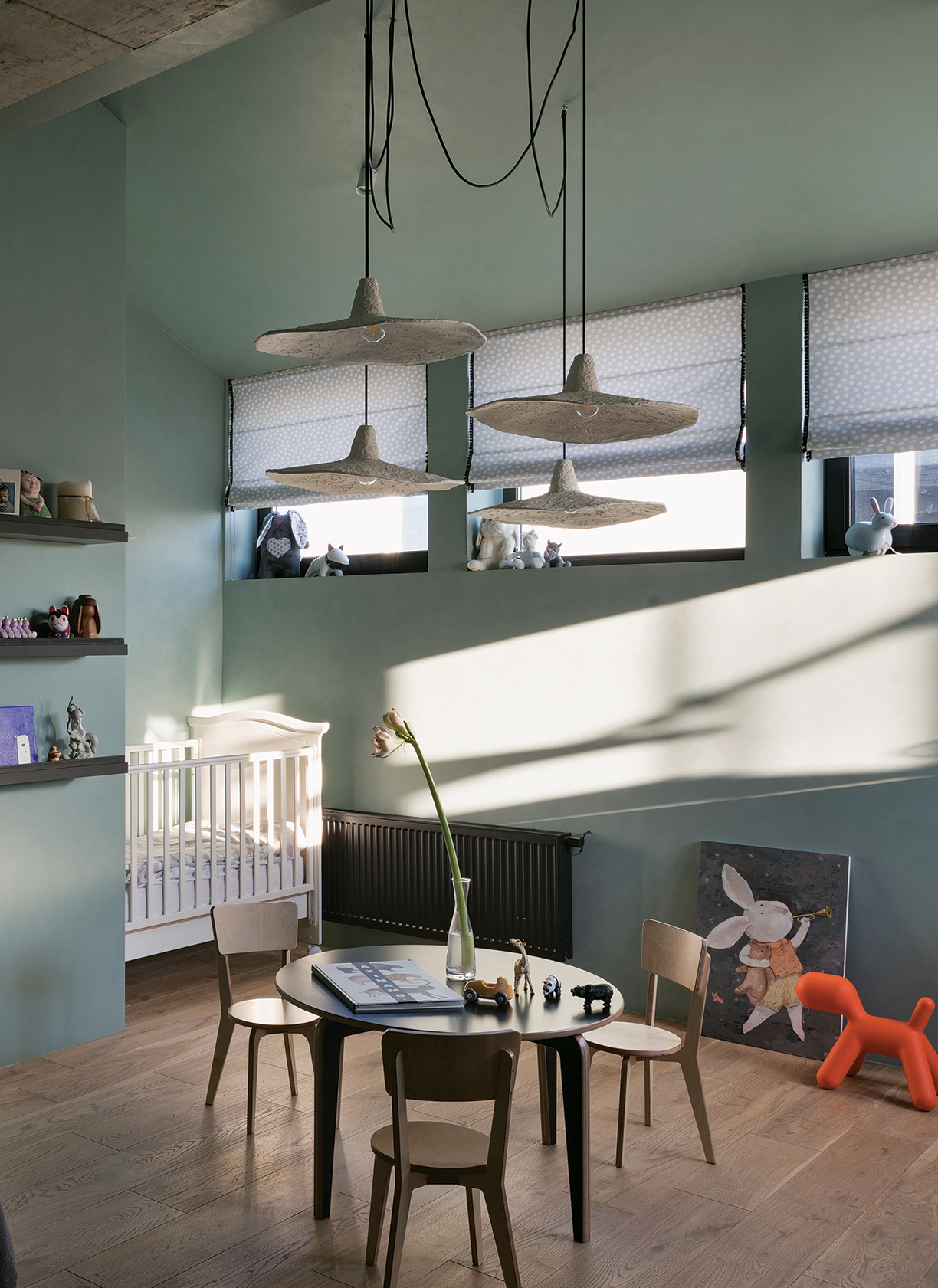
PHOTOS BY ANDREY AVDEENKO
Kamoshita agrees that kintsugi is similar to wabi-sabi, as both practices aesthetically represent imperfect beauty that prevails despite wear and time. “All things continue to change. Even ceramics,” she says. “Anything can break for any kind of reason. It’s sad, but you can revive it with your own hands,” giving it back a sense of adoration and cherishment. This new life further continues an object’s story and embodies beauty in simple things, which encompasses wabi-sabi. As Makhno himself notes, “the story is that things can be repaired, not thrown away.”
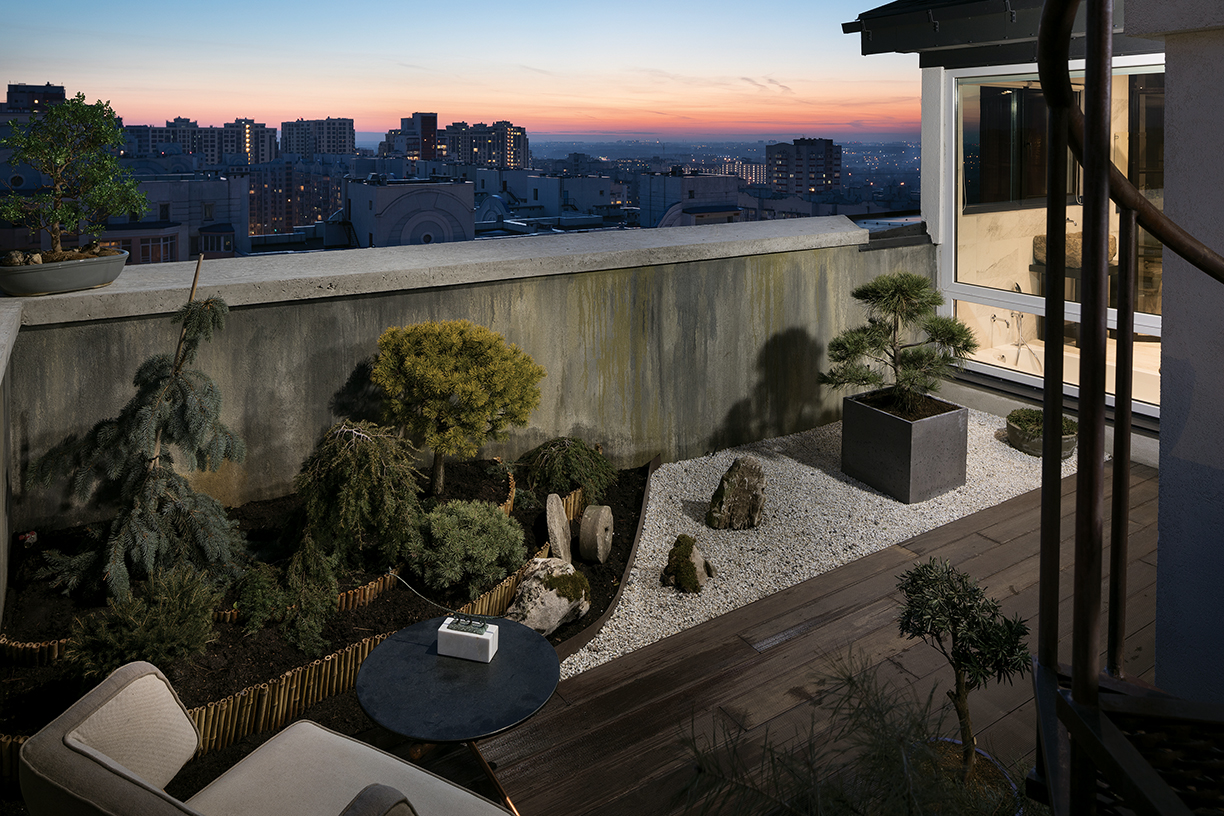
PHOTO BY ANDREY AVDEENKO
This editorial originally appeared in The High End Winter 2020.
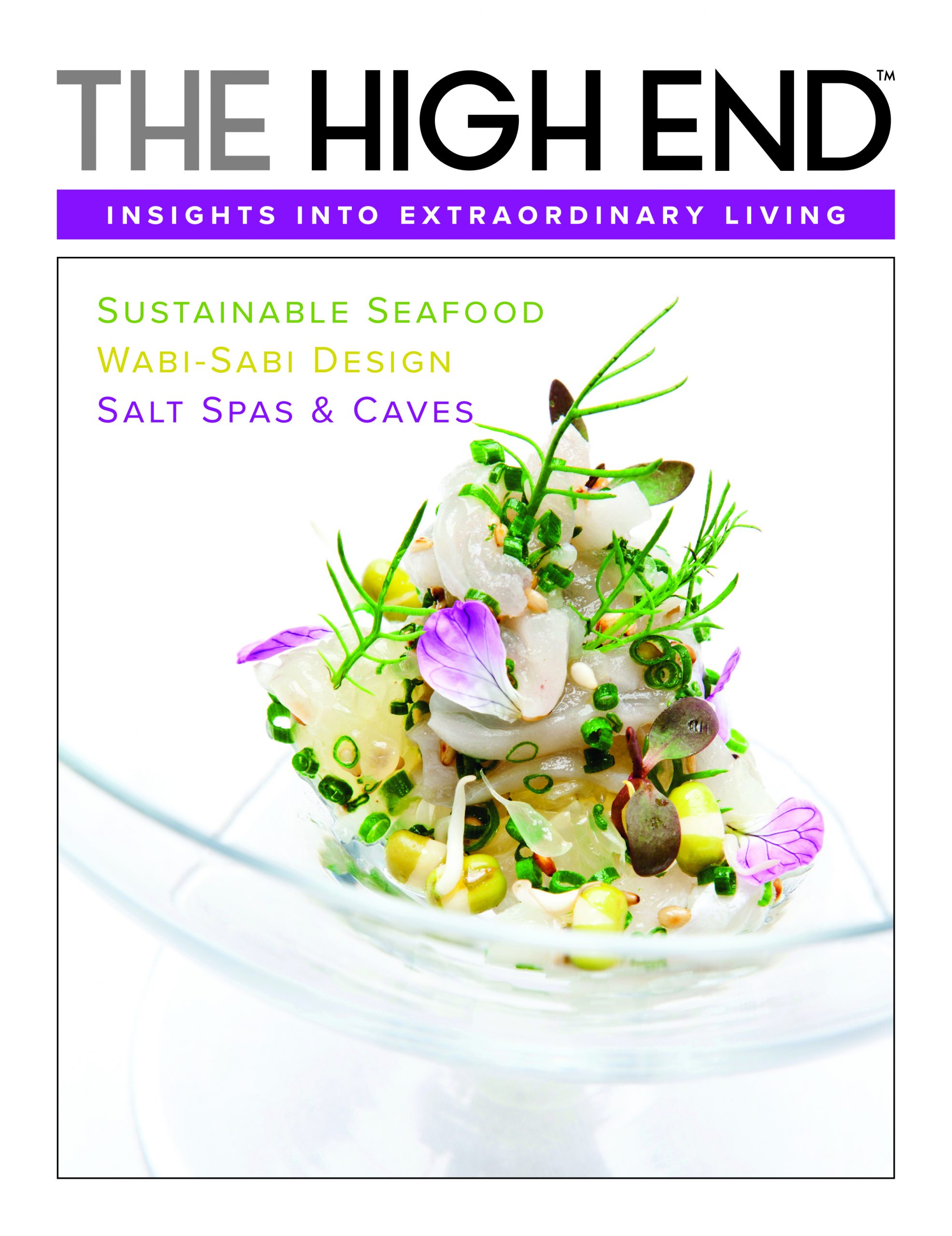
Whether working in busy urban studios or quiet countryside spaces, there’s no denying that makers and creators remain an integral part of Ireland’s culture and workforce. From painted canvas and chiseled stone to woven tapestries and hand-sewn clothing, the art of the handmade item is alive and well.
In fact, General Paints Group is telling the story of what it means to craft and create in Ireland in the only way it knows how: through color.
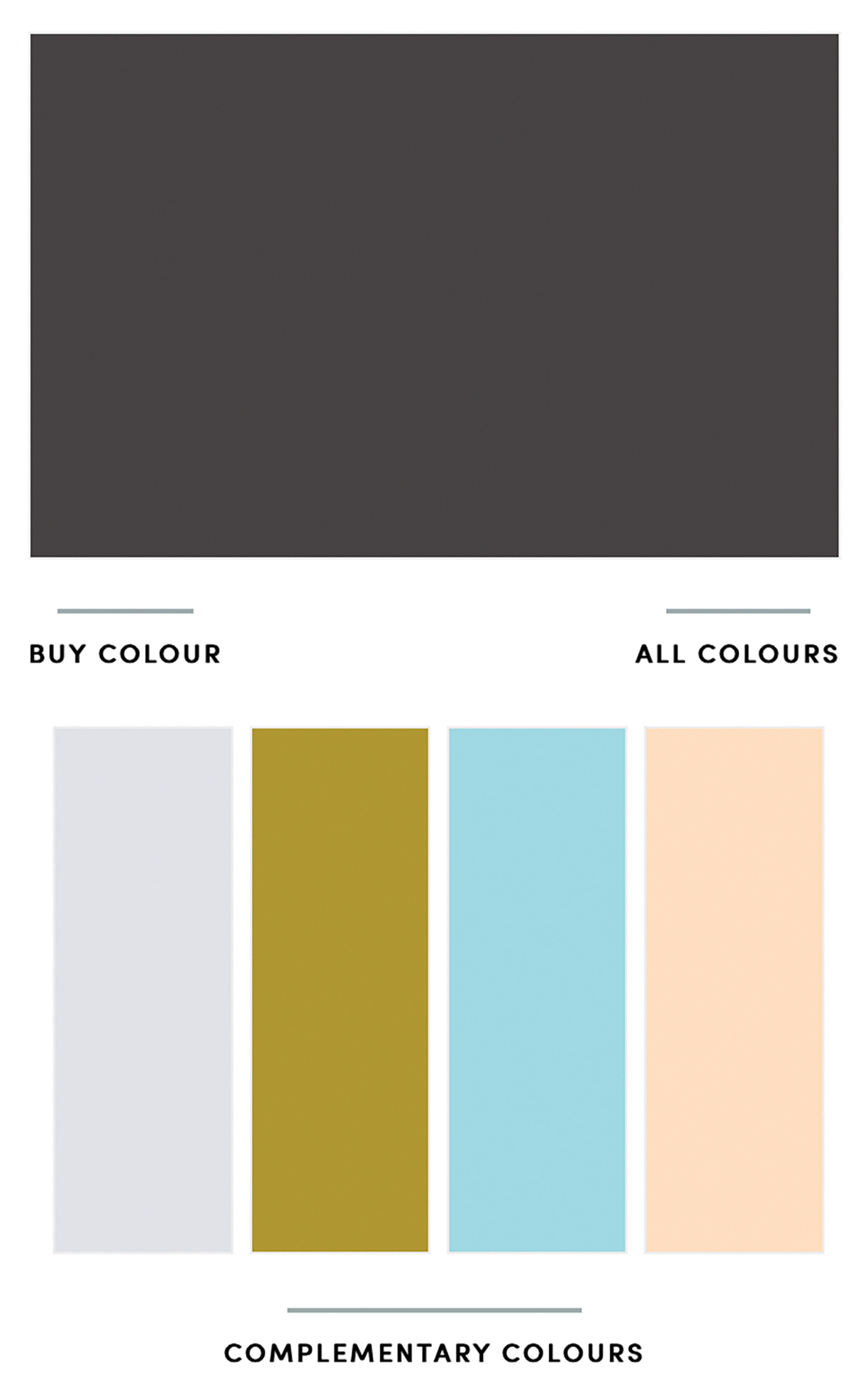
The company’s new Curator collection features 144 unique paint colors developed and sourced from artists who focus their creative endeavors in Ireland. The palette presents everything from neutral hues that speak to the quiet woodlands of West Cork to bolder shades that evoke the country’s strength and spunk.
“From the very beginning, we wanted to make a collection that was authentic, special and genuine,” says Rachel O’Connor, expert director for General Paints Group and one of the developers of the Curator brand. “[The artists] all had colors that really meant something to them and inspired their work. And for a lot of their work, their muse was Ireland and our lovely landscape.”
O’Connor, who is also heading up Curator’s U.S. presence, says that develop-ing and sourcing the palette was a nearly five-year journey. After extensive searching, the team worked with 29 Irish designers and artisans to discover the history and heritage behind the colors that inspired them. Although the concept of the palette changed along the way, O’Connor says the goal of capturing “the passion they bring into their work” remained a driving force
O’Connor, who is part of the third generation of General Paints Group’s 65-year history, also points to her company’s own entrepreneurial spirit as part of the collection’s inspiration.
“We’ve always had an admiration for artists and craftspeople. Many are solo entrepreneurs who are doing what they love. We worked with a broad range of artists — potters, millers, sculptors — and although they’re all different, they had one thing in common, and that was color,” she says.
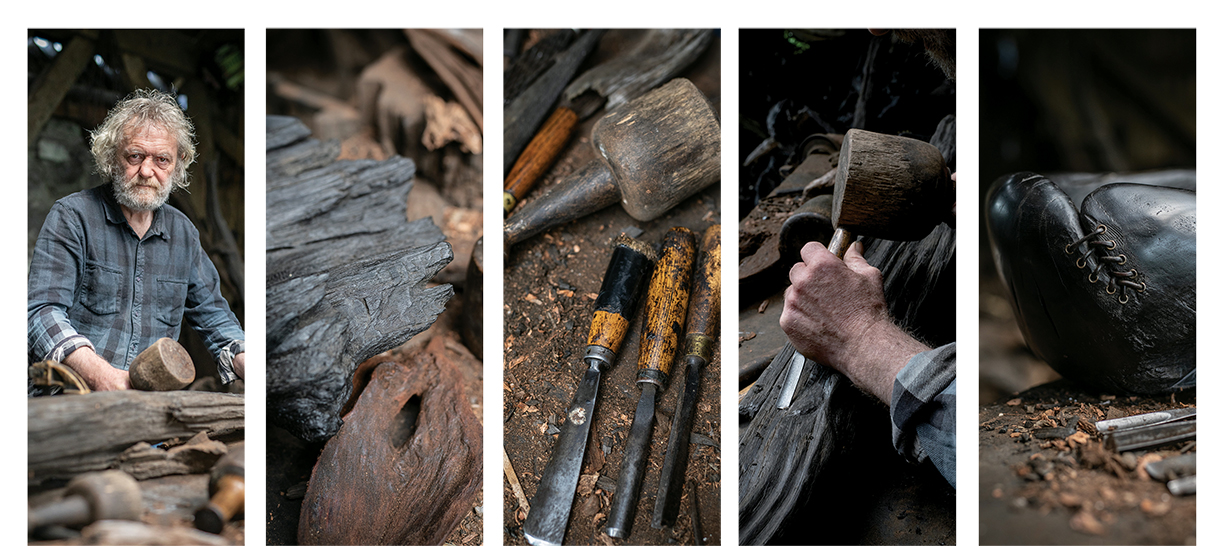
Ronnie Graham.
O’Connor speaks fondly of the stories within the pigment and describes some of the bolder colors in the palette. There’s Ancient Black, inspired from the creations of sculptor Ronnie Graham. O’Connor describes the lore of this deep, moody color as “haunting and mystical.”
“[Ronnie] works with what’s called buried oak — it’s oak that’s been buried in a bog for thousands and thousands of years. During the preservation process it turns a beautiful charcoal color,” O’Connor says. “Ronnie believes it emits a mystical power — and he tries to capture that in his sculptures. Interestingly, it’s been one of the most popular colors in our market.”
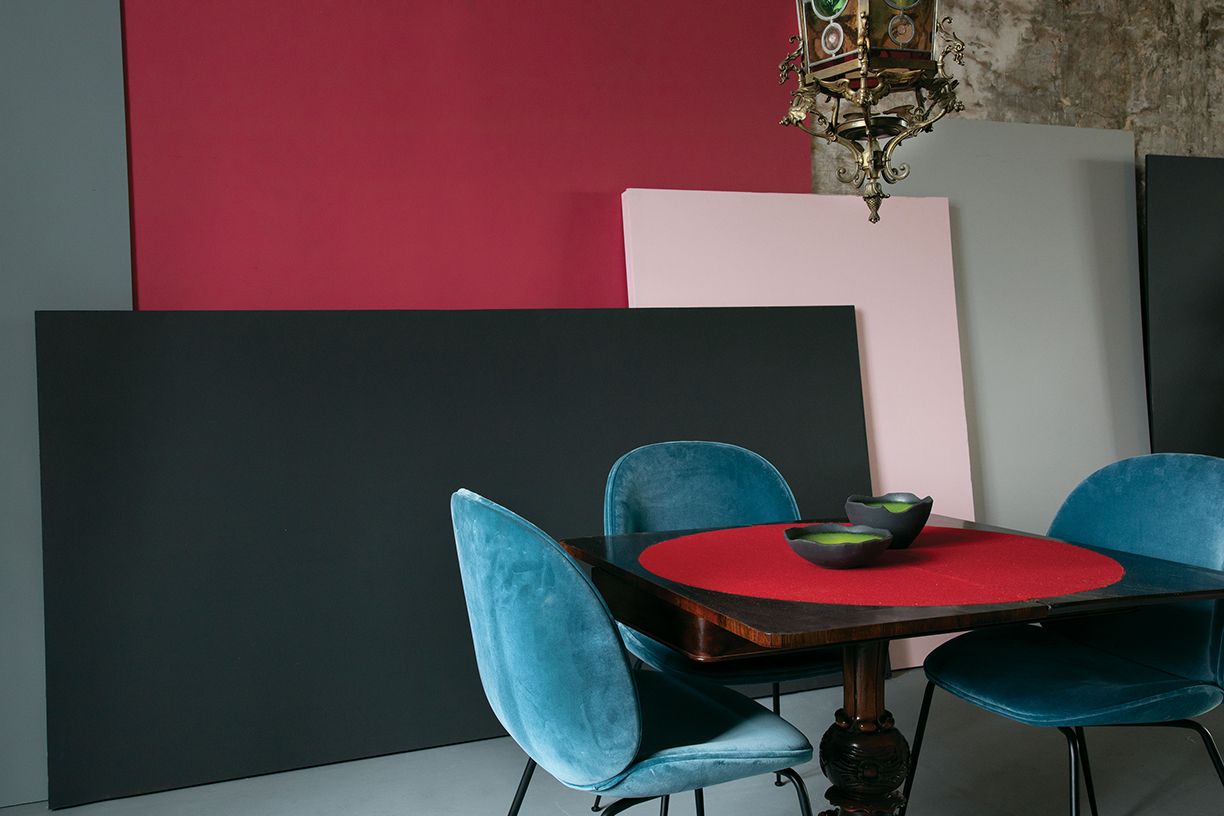
The Curator collection was intentionally designed to easily discover and combine complementary shades. Here, Ancient Black is paired with Kerr’s Pink and Rose Mantel.
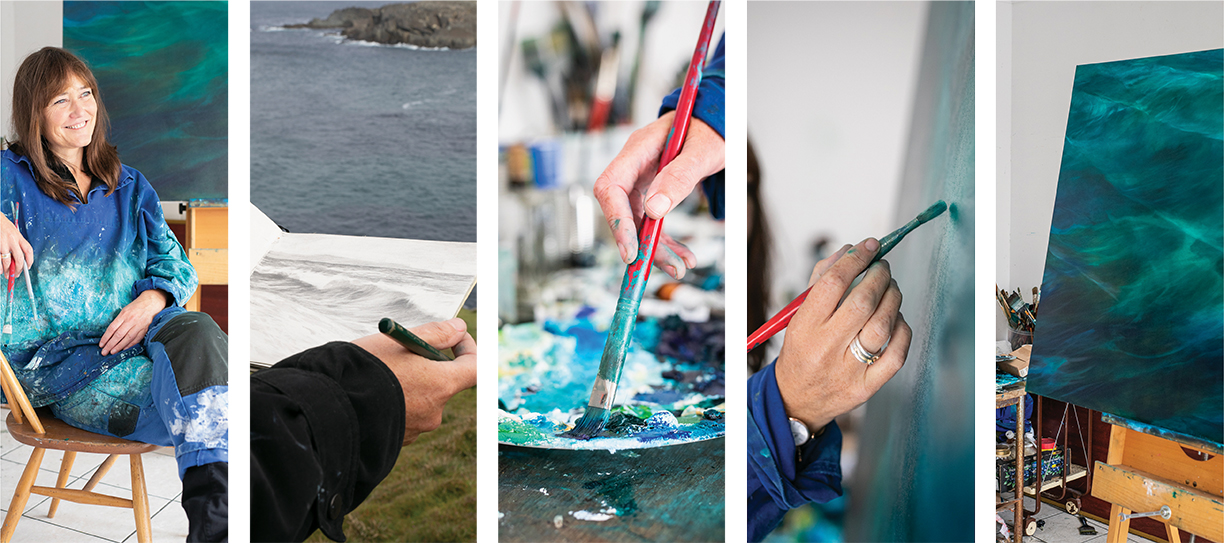
Carol Cronin.
O’Connor also suggests the colors can be used seasonally — such as on flower boxes and planters, furniture or even doors; she describes charming Irish neighborhoods with bright pink, turquoise and other colors adorning the front doors of homes. “But we don’t like to be too prescriptive. There’s no such thing as a wrong color combination,” she adds.
Even the palette’s more traditional hues have a story that is anything but. Horseshoe, for example, is a stone-gray shade, aptly named for Horseshoe Mountain in County Sligo, Ireland, that inspires pottery artist John Ryan.
O’Connor’s personal favorite paint is also bright and bold: Running Tides, a bril-liant aquamarine unique to the seascape paintings of Irish artist Carol Cronin, who has captured the Atlantic Ocean on canvas for decades. (“You might think you could get bored of painting waves, but [her works] are stunning,” O’Connor says.) These brighter, livelier shades off er the “pop of color” that O’Connor sees throughout the commercial interior design market.
“People are starting to be less afraid of taking risks with pops of color. We’re seeing a lot of restaurants, hotels and public spaces take bolder risks. We think it’s a great trend,” she says.
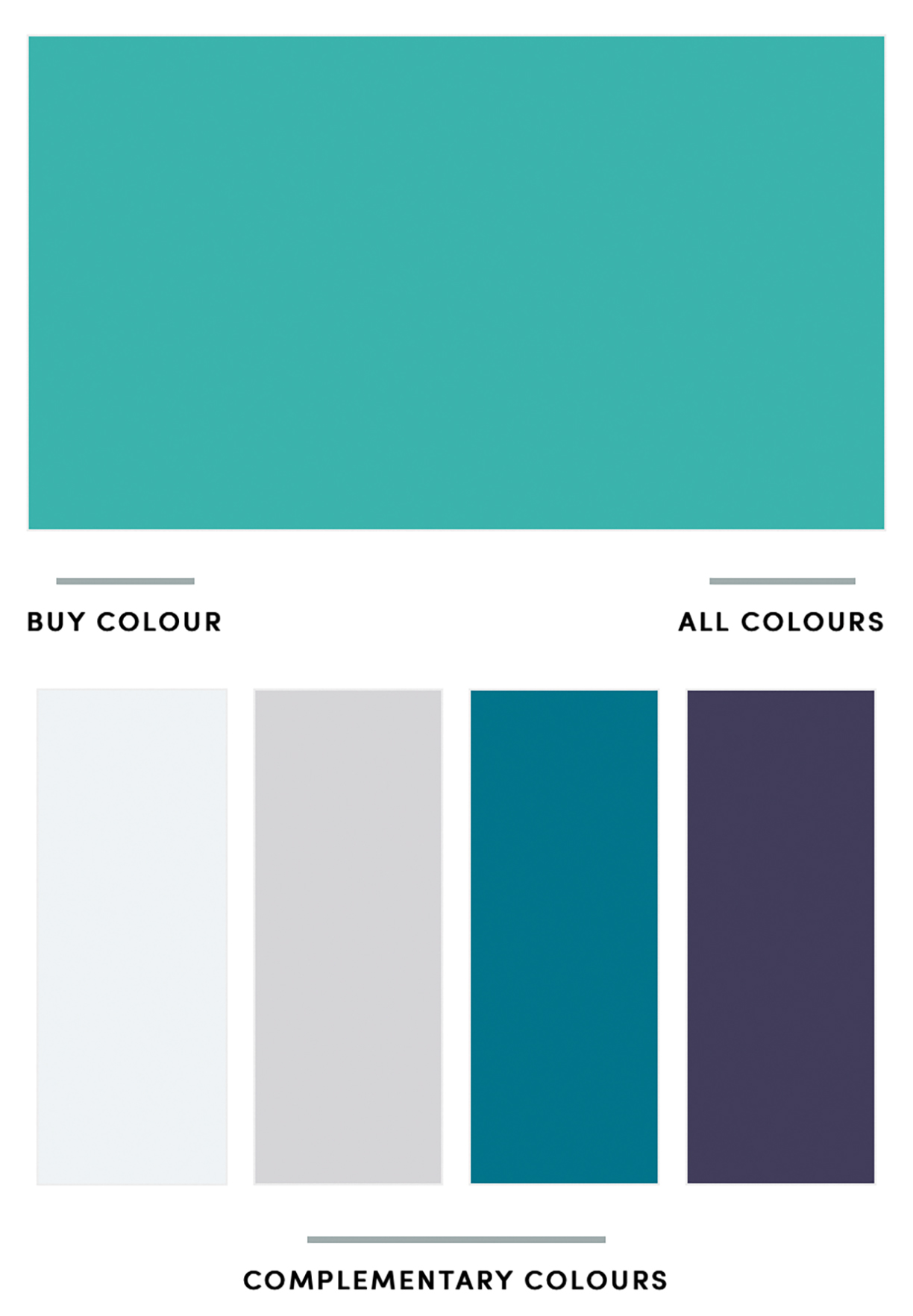
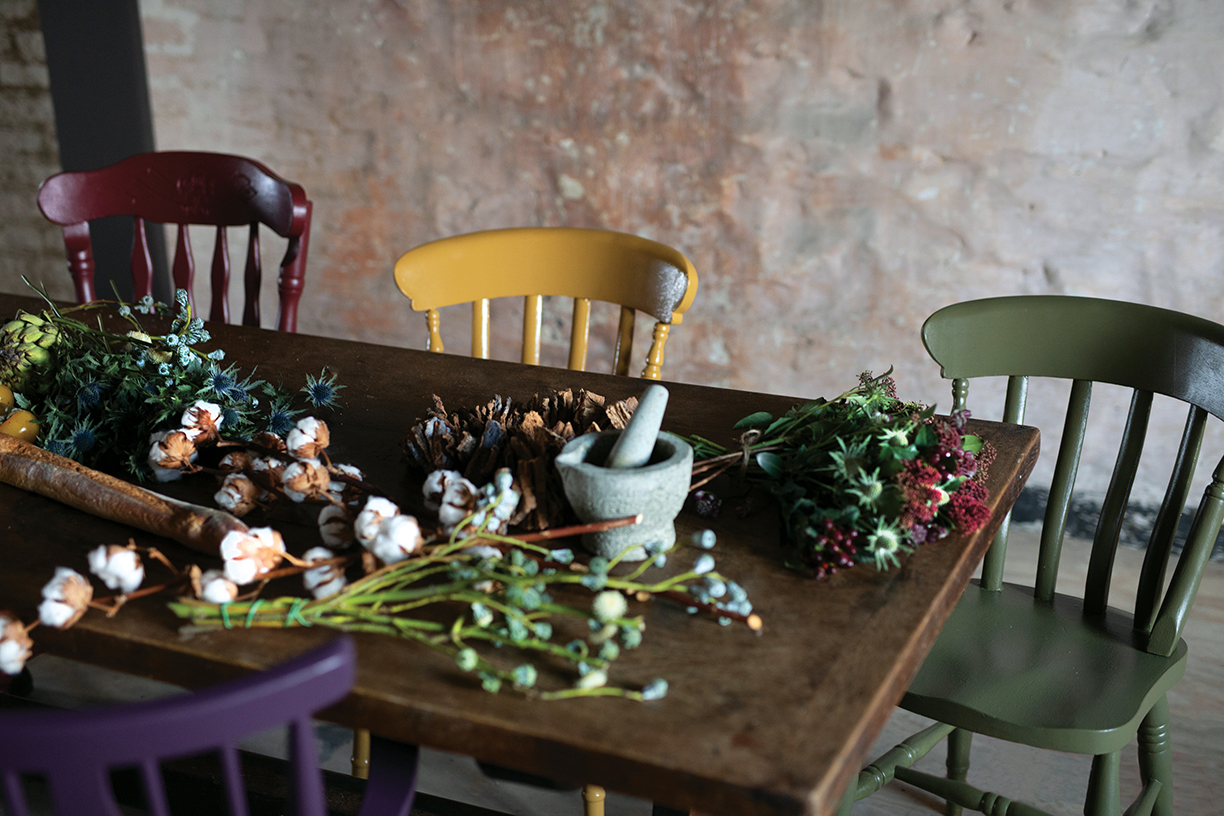
The collection boasts shades like Pulled Rhubarb, Tailored Tweed and Dried Kelp (painted on chairs left to right) that ad richness and depth to ordinary spaces.
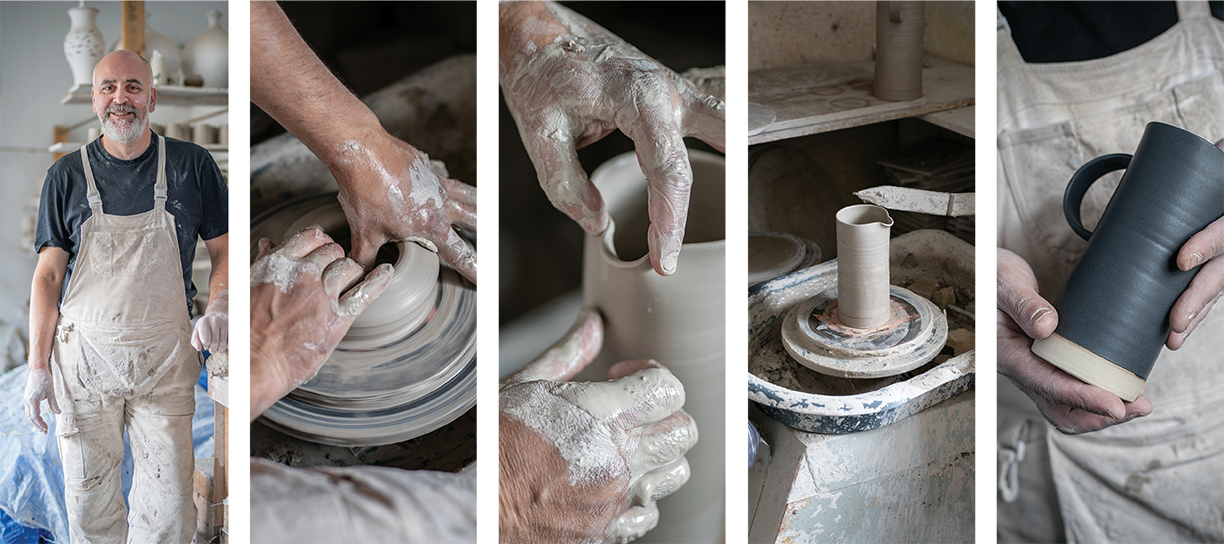
John Ryan.
“[Ryan] is immersed in the landscape surrounding his workshop, and it inspires these stunning creations,” O’Connor says of the potter’s handmade ceramics. “The color really shines through in his work.”
The collection made its U.S. debut ear-lier this spring in Connecticut and arrives on the West Coast in the fall, including southern California, Portland, Oregon; Scottsdale, Arizona; and Seattle.
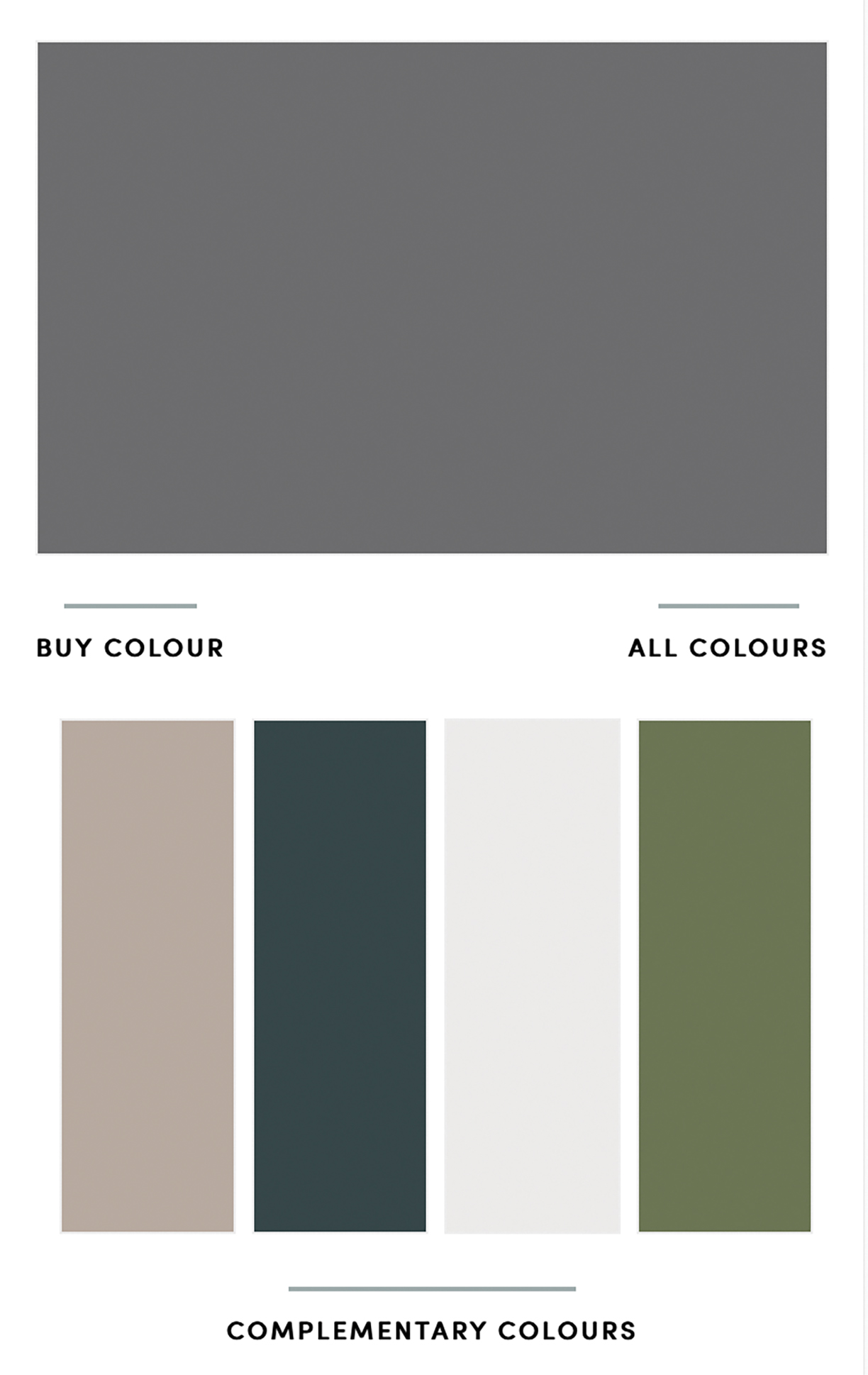
Ultimately, the collection aims to not only honor these artists, but to inspire others to use color to express creativity and passion, says O’Connor. And in a way, that allows the consumer to play curator and tell their own story.
“The collection [is a] showcase of Irish craft and talent, but it goes beyond that,” O’Connor explains. “I think home is deeply personal to people. You want it to reflect your identity and personal style. When you bring a color into your home, you’re looking for more than just paint. In our collection, every color has a meaning and personality. [It’s] allowing the customers to be their own curator.”
The collection is currently sold at Ring’s End as well as McDermott Paint & Wallpaper in Connecticut, and is also available for purchase at curator.com.
All photos and featured photo courtesy of General Paints Group / Curator.
This post originally appeared in the Fall ’19 edition of The High End.
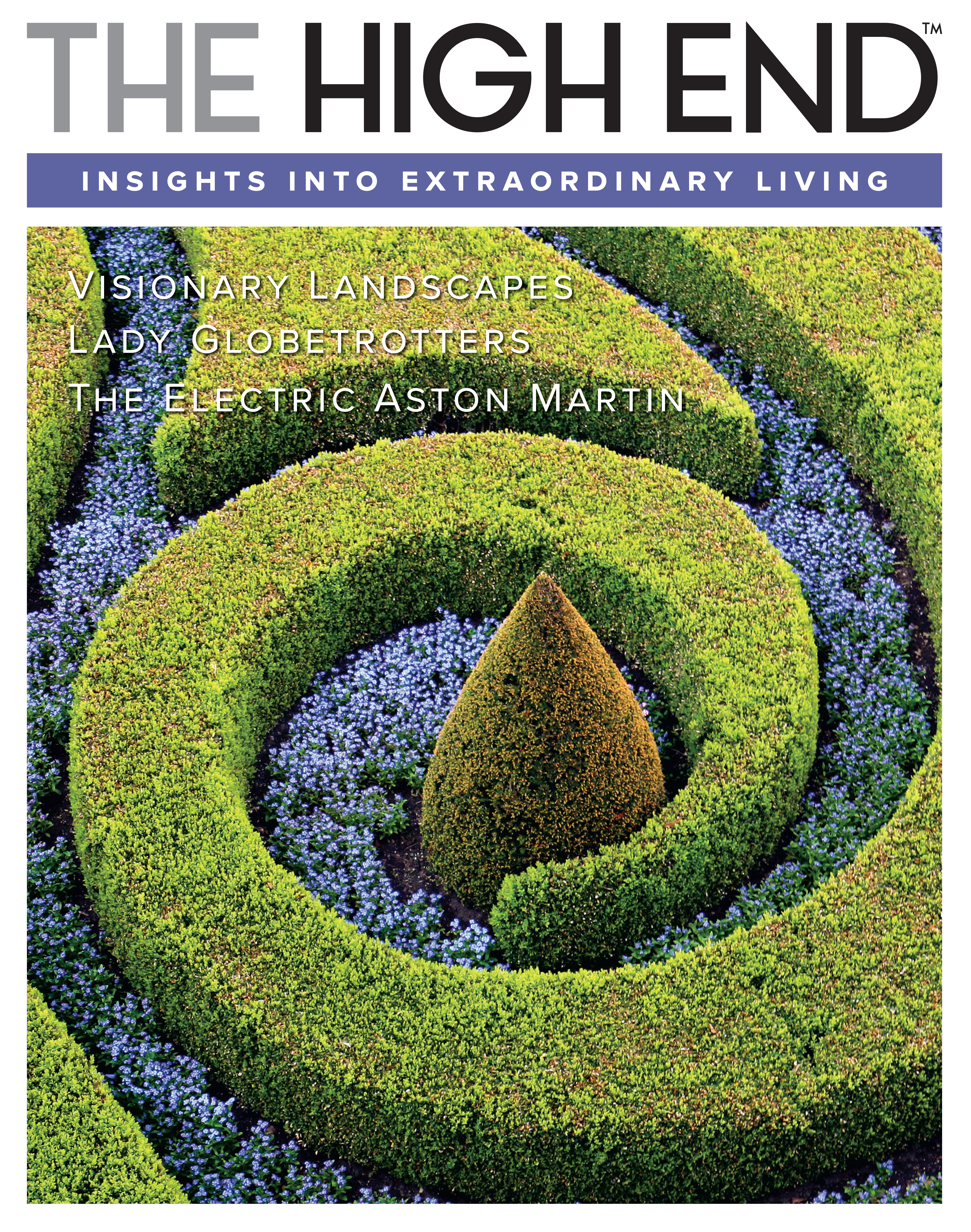
Aston Martin is once again wowing drivers with two new vehicles that have all the pizazz and none of the pollution.
The luxury carmaker held its inaugural Electric Future event in late June to showcase two all-electric models — The Rapide E and Lagonda Vision Concept — at Aston Martin Mayfair in London.
Relaunched as the world’s first zero-emission luxury brand in 2018, Aston Martin’s Lagonda line aims to leverage the latest advances in electrification and autonomous driving technologies while maintaining “a unique niche in the market,” says Marek Reichman, chief creative officer at Aston Martin Lagonda.
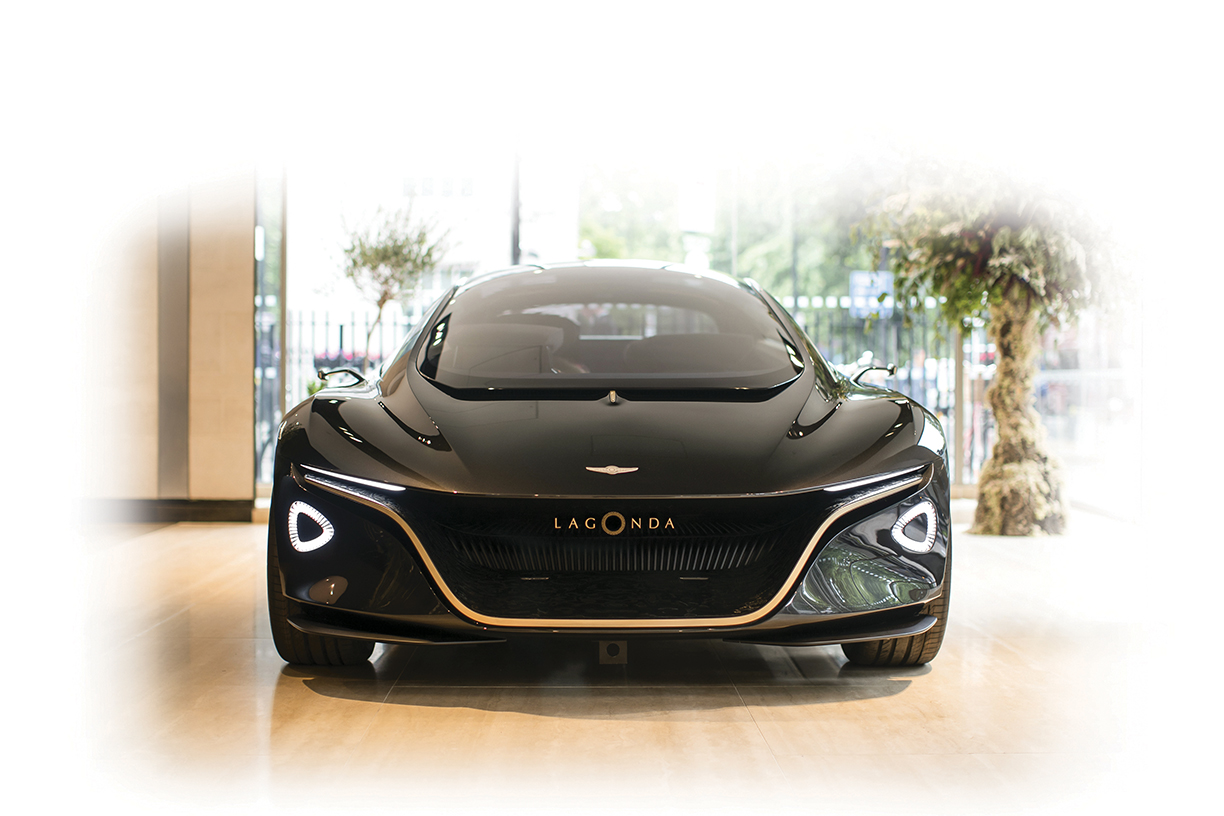
Aston Martin Lagonda Vision Concept.
“We set ourselves an ambitious target to be the world’s first luxury electric brand,” he says. “[Lagonda] is for the high-end luxury customer who wants to explore and be autonomous while remaining mindful of the impact they are having on the enviro-ment. Lagonda will achieve this but it will also delight the people who get to enjoy its unique internal environment.”
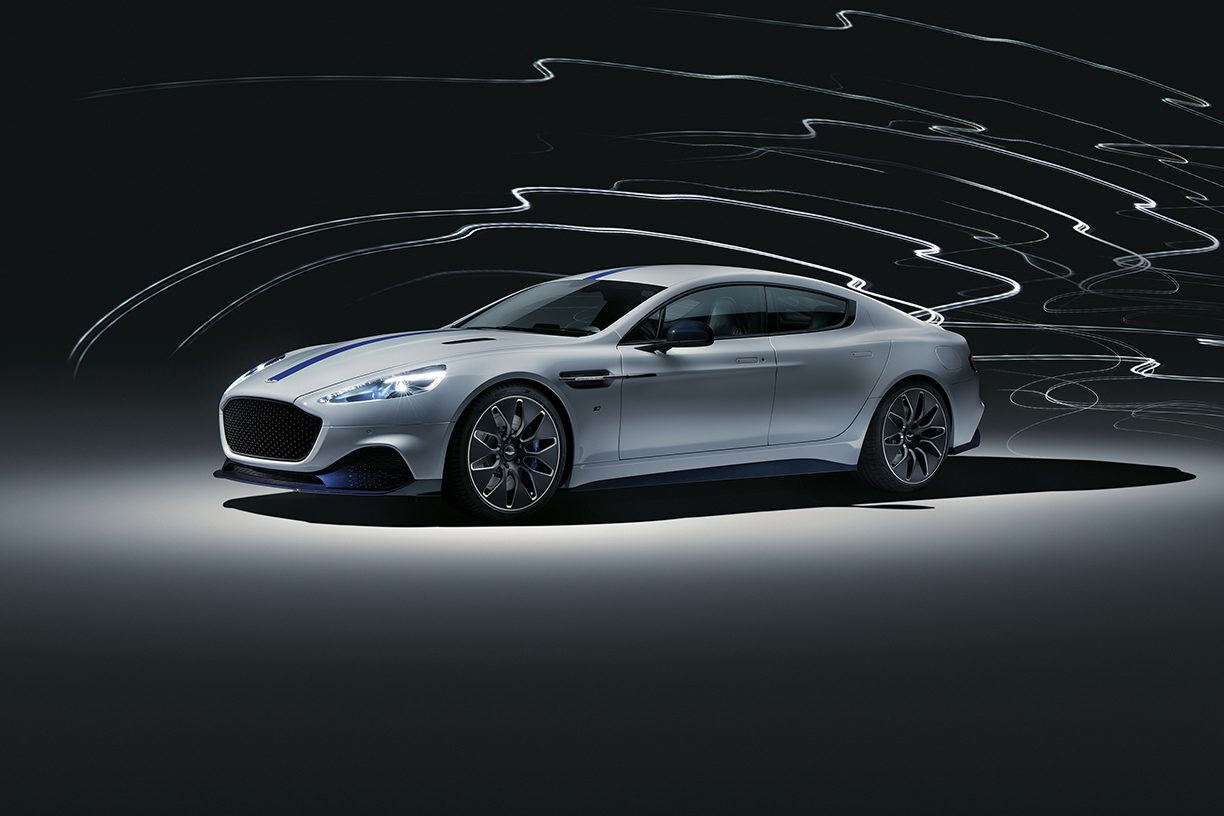
Aston Martin Rapide E.
The Electric Future featured the Rapide E, the company’s first electric sports car, as well as the Lagonda Vision Concept, the latter of which first turned heads at the Geneva Motor Show in 2018. The sleek vehicle’s four-passenger interior doubles as a stylish space, with cashmere interiors and swiveling fronts seats. The Vision Concept is designed as a self-driving vehicle, and it’s expected to enter production around 2022.
Meanwhile, the Rapide E has already delighted drivers across Europe and Asia, making a flashy debut in Morocco and Shanghai in spring. With a design that was based on its V12 predecessor, the Rapide AMR, it’s no surprise that the Rapide E clocks in at a max of 155 mph — all on an 800-volt battery.
The car boasts twin electric motors that produce 610PS and 950Nm of torque, allowing it to zip from 0 to 60 mph in less than four seconds, and can manage the jump from 50 to 70 mph in 1.5 seconds.
On the inside, the car’s digital gadgets include a sleek display for battery and energy information, and Aston has also developed a smartphone app to monitor the car’s battery life and parking spot, among other features.
According to John Caress, vehicle line director, the Rapide E drives a little more than 200 miles on battery power alone, which can then be recharged from 0 to 80 percent in just 35 minutes — so you’re back up and on the road in no time. It’s expected to enter production at the end of the year, with a limited run of 155 vehicles.
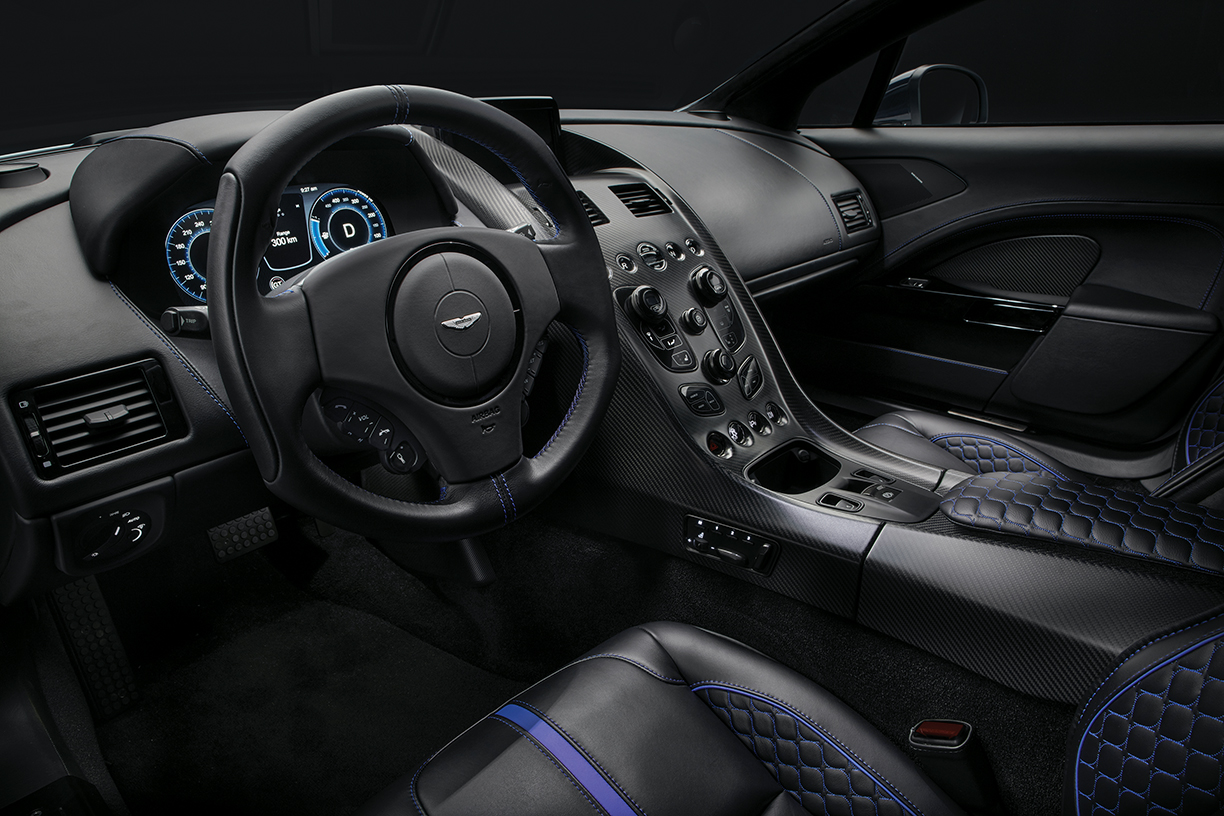
Aston Martin Rapide E interior.

Aston Martin Rapide E charges at its electric port.
“Rapide E is proof of Aston Martin’s commitment to its Second Century Plan. Having an electric powertrain is no longer just a vision for our company, it’s reality. We are producing fully electric vehicles which will form part of our future strategy that will culminate when the first Lagonda vehicle enters the market,” he says.
Pricing is not yet available for these models. Explore all Aston Martin vehicles at astonmartin.com.
All photos and featured photo courtesy of Aston Martin.
Exploring the world on two wheels offers an experience like no other, providing an addictive free-wheeling freedom that you just can’t get from the confines of a typical automobile. These high-end motorcycle models set in motion the future of contemporary riding. Designed by some of the most iconic American motorcycle manufacturers, and European competitors, these bikes promise a variety of devil-may-care cruising — from smooth, solitary highway grand touring to gutsy track-inspired journeying across unpredictable curves and stretches. There’s nothing like the open road.
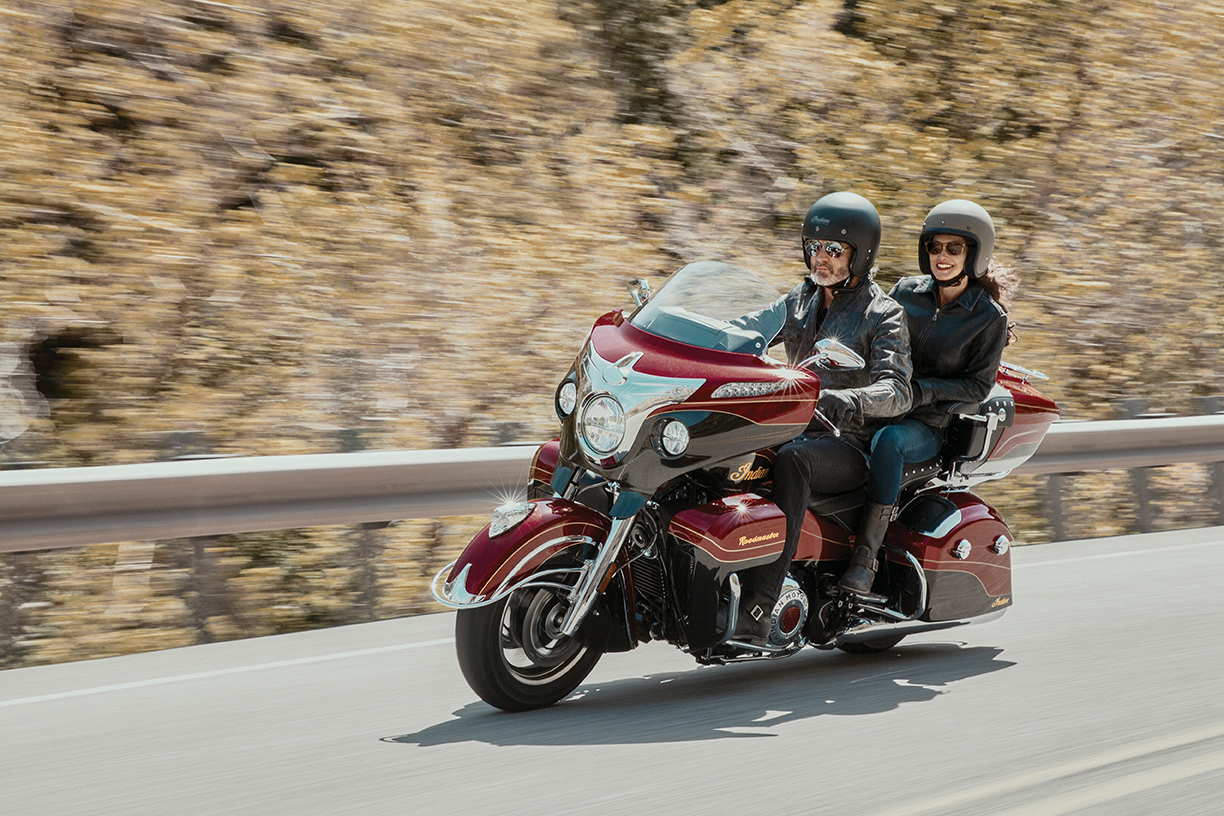
Indian Roadmaster Elite. Photo courtesy of Indian Motorcycle.

Photo courtesy of Indian Motorcycle.
Indian Roadmaster Elite
Starting at $36,999
The Roadmaster Elite from iconic American motorcycle manufacturer, Indian, is packed with the comfort and force needed for the open road, making it the ultimate master roadster. The luxurious machine features two-tone paint in “Red Candy” over “Thunder Black Crystal” that takes a whopping 30 hours to complete and fi nish by hand; and the logo badging is embossed in 24-karat gold leaf trim, sure to catch the sunlight in the passing lane.

Photo courtesy of Andy Mahr, Harley-Davidson Motor Co.
Harley-Davidson CVO Limited
Starting at $43,889
An enduring symbol of Americana, Harley-Davidson ensures time-honored performance and design that lives in the realm of cultural icon. The 2019 CVO Limited offers loyal Harley-Davidson riders the grandest experience of American touring by fusing contemporary elements with classic design. Technology-forward integrations allow for a plugged-in cruise atop the most powerful V-Twin engine ever offered from the company — the Milwaukee-Eight Twin-Cooled 117 Engine, which is only available in CVO models.

Photo courtesy of Triumph Motorcylces LTD.
Triumph, Rocket III Roadster
Starting from $15,775
The signature twin-headlights look of British motorcycle manufacturer Triumph’s Rocket III Roadster has just as much impact as its powerhouse engine. This premium flagship bike’s blacked-out silhouette, chrome headers and detailing confirm that looks, can in fact, kill. If you live to start the engine, hold a solid grip because the world’s largest production engine has more torque than ever. Fit with a three-header exhaust that growls deep to make your presence known on the road, this cruiser is all about free and easy riding.

Photo courtesy of Arnold Debus.
BMW, K 1600 GTL
From $25,995
The K 1600 GTL by BMW is one of the fastest and most luxurious touring bicycles on the road. Prioritizing comfort, the motorcycle features a significant amount of space to easily conquer a long journey with a partner along for the ride. With cutting-edge sport touring technology, a six-cylinder in-line engine, and a multi-controller concept that allows you to switch functions without ever taking your hands off the handlebars, this bike was made to go the distance — in any weather condition. The K 1600 GTL is for the traveler who desires a reliable bike for a relaxing and equally high-end experience. Sit back and enjoy the ride.
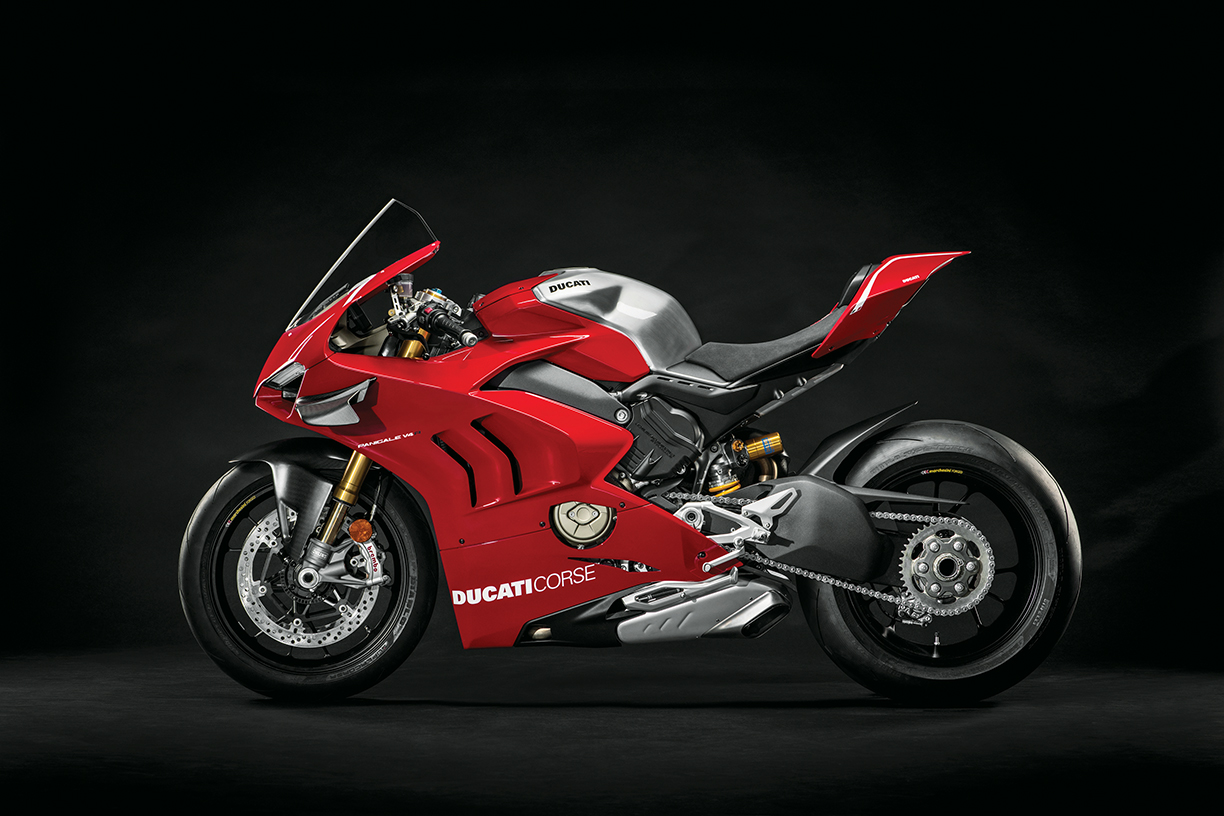
Photo courtesy of Ducati Motor Holdings S.P.A.
Ducati, Panigale V4
Starting at $21,295
The Panigale V4 by Italian company Ducati is one of the fastest road-legal racing bikes to hit the market. The aggressive frame allows riders to throttle through curves and launch on straights; sophisticated electronic controls unlock the reigns beyond standard limitations. The bike is a true celebration of Ducati’s long-lasting racing spirit. Designed to treat the freeway like the track, this efficiently aerodynamic bike is for the true daredevil motorcyclist.
Colors, materials and the overall aesthetics often take the spot-light, while functionality takes a back seat. But storage, organization and tech-enabled appliances are as much the heart of kitchens today as cabinets and hardware.
As the overall look for kitchens becomes more cohesive, functionality might be even more important, as maintaining a sleek aesthetic requires a subtle integration of storage and dedicated zones for everything from baking to beverages. Equally transformative is a growing array of tech enhancements that promise real value for consumers. All of which ensure the most beautiful kitchen also will be up to the tasks required of the hardest-working room in the home.
“Regardless of the size of the kitchen, the main design challenge is to balance space given to appliances, storage and work surfaces,” says Mary Jo Peterson, an award-winning author, educator and designer and president of Mary Jo Peter-son Inc.
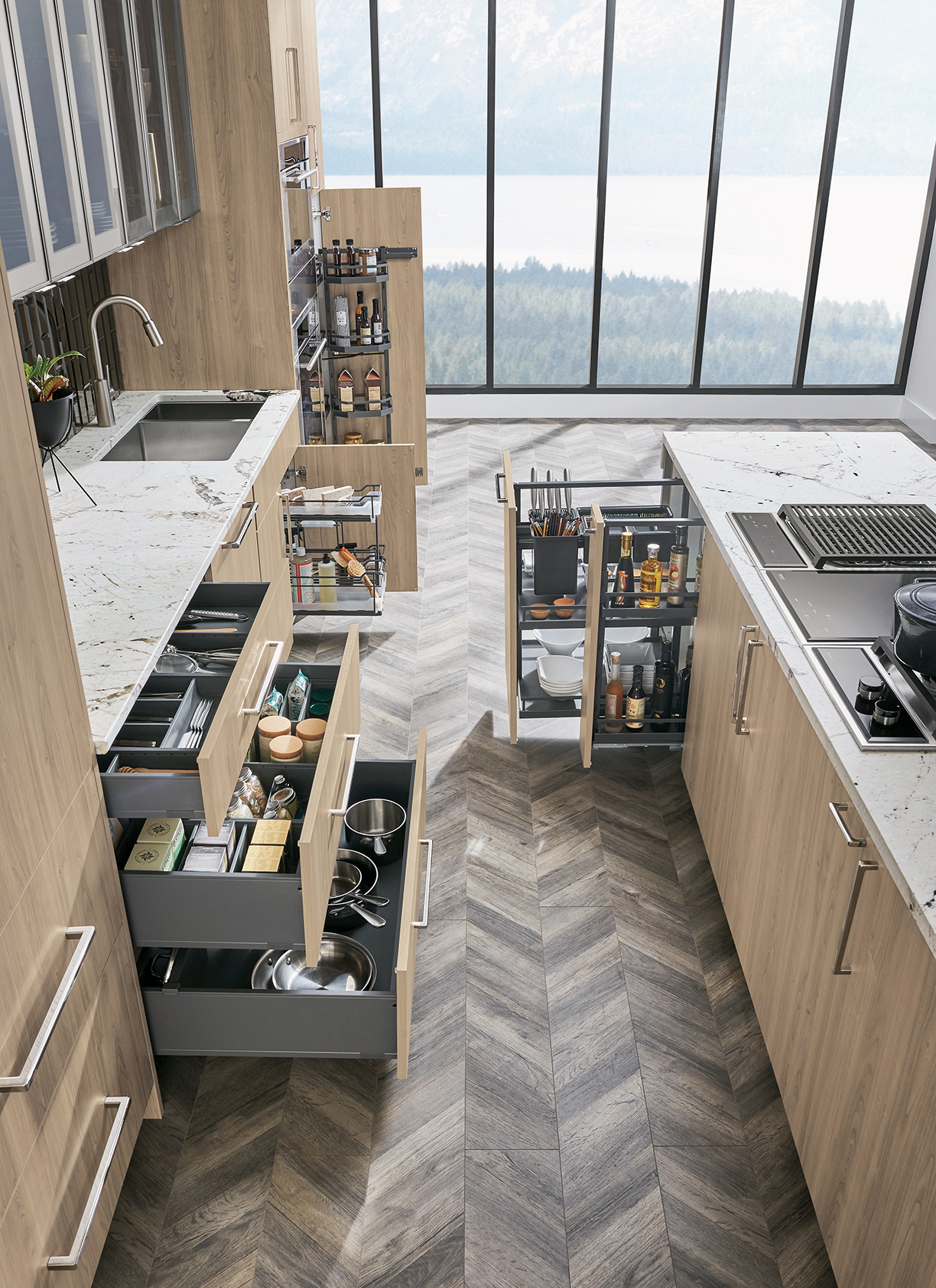
More windows and fewer walls moved storage to base cabinets. Interior storage solutions tailor a kitchen for an individual’s lifestyle and preferences. Photo courtesy of Masterbrand Cabinets.
“It’s a functional area and how your work in the kitchen is an important consideration,” says Stephanie Pierce, director of design and trends at MasterBrand Cabinets. Especially with high-end clients, she says, designers’ conversations have evolved to be more about lifestyle than appearance and style preferences. This all ties into the shift toward personalization of both aesthetics and function in homes.
In the last 10 years, she says, the industry as a whole has tripled the storage solutions offered to consumers. Additionally, there is a much greater focus on customization and adaptation for specific uses, which enables consumers to create the amount and the type of storage uniquely geared toward their use of the kitchen and their lifestyle. As an example, Pierce points to a cabinet designed specifically for dry goods. “That’s not something we would have seen five or six years ago. We would have tried to do something that was much more versatile and generic that could work with anyone’s objective.”
Amping up the need for enhanced storage and organization is an ongoing change in kitchen design. Several years ago, Pierce says, they identified an emerging trend of adding add light to kitchens with more windows and fewer walls. The end result? Storage moved to base cabinetry and, more recently, to floor to ceiling cabinets. Pull-out drawers offer the most versatility, according to Pierce, and recent research shows 79 percent of designers identified wide drawers as the top kitchen feature.
Kitchens have not only become a main place to entertain, but also a hub for a range of activities from charging devices to home-work to functioning as a home office. This is not a new trend, but Annelle Gandelman of A-List Interiors says, “lately, more peo-ple have been asking for dedicated spaces within the kitchen that cater to guests specifically. We get a lot of requests for coffee bars, butler’s pantries, and even breakfast bars filled with specialty appliances integrated into the cabinetry.”
Phil Kean sees a bar for liquor and wine gaining interest among consumers, which also moves some entertaining into areas adjacent to the kitchen. The New American Home 2019, a concept house designed and built for the home builders’ annual trade show, featured a large bar situated between the kitchen and great room that functioned both inside and outside the home. This year, Thermador introduced a dishwasher just for glasses. Kean says it’s interesting to see an appliance with such a specific function. “I think we’re going to see that more often. People might want to have a second dish-washer in their bar.”
Other specialty appliances requested for bars and beverage centers include refrigeration drawers, ice makers, instant hot faucets, drawer microwaves, convection ovens and wine refrigerators, according to Gendelman. Interestingly, one appliance that’s become a “must have” for upscale kitchens is a built-in coffee and espresso maker. Introduced at the kitchen and bath show (KBIS) this year was a faucet that delivers filtered boiling water as well as sparkling water and normal filtered water.
For high-end kitchens, the big story currently revolves around butler’s pantries and second kitchens. “We find that even people who don’t cook will invest heavily in their kitchens because it’s not just about function and food prep but also where people spend most of their time. As a result, the messier, uglier parts of a working kitchen are being moved into pantries and smaller back kitchens. These spaces are where the toaster ovens, slow cookers and ugly appliances are being hidden,” says Gendelman.
Pierce agrees. “We’re seeing fewer countertop appliances being visible,” she says. Another emerging addition to the kitchen is something Pierce calls the “walk-through pantry,” which essentially looks like a traditional cabinet door to a pantry. But open the door, and it takes you to an entire secondary kitchen that she says can be “massive.” Often it will have a sink and a second refrigerator. “It’s basically a prep kitchen that is also designed toward food storage.”
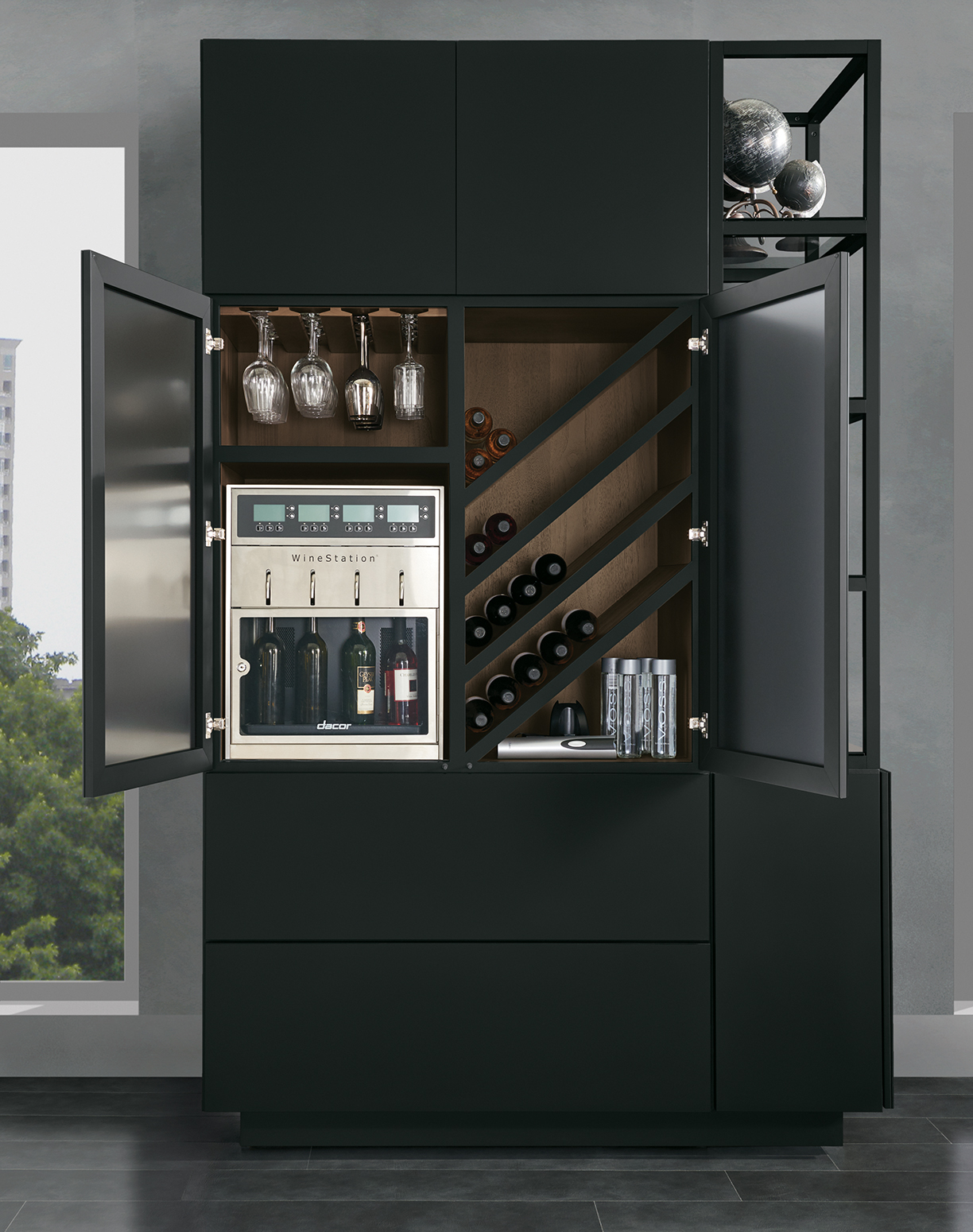
Dedicated spaces for entertaining, such as this wine cabinet, please both hosts and guests, easing congestion in the main kitchen. Photo courtesy of Masterbrand Cabinets.
“Convenience is luxury,” observes Gendelman. Motorization is a convenience, particularly in contemporary kitchens, where cabinet doors, even some appliances, open in response to a slight push. Additionally, manufacturers have introduced a range of ways to open cabinets, including doors that tilt upwards, allowing users to leave cabinets open without interfering with traffic patterns.
Consumers also see the value of technology as a way to create convenience. In research from the National Kitchen and Bath Association, 72 percent of consumers believe technology “adds market value to my home.” “Saves me time and steps” was perceived as a main benefit of kitchen technology by 70 percent of those surveyed. A majority also said kitchen tech is important because “it makes my life easier.”
In this research, consumers outpaced designers in their enthusiasm for and understanding of technology. There was strong approval and interest in smart appliances and tech solutions that enable consumers to control various aspects of the home from the kitchen, as well as solutions that make meal ideas/preparation easier and more enjoyable. Very appealing tech features for a large majority of consumers include appliances/faucets that send remote failure/leak alerts; cooking appliances that sense over-cooking or being left on; hands-free faucets with Wi-Fi interconnectivity; appliances that can be activated remotely; and sensors that can monitor/communicate food inventories in your cabinets.
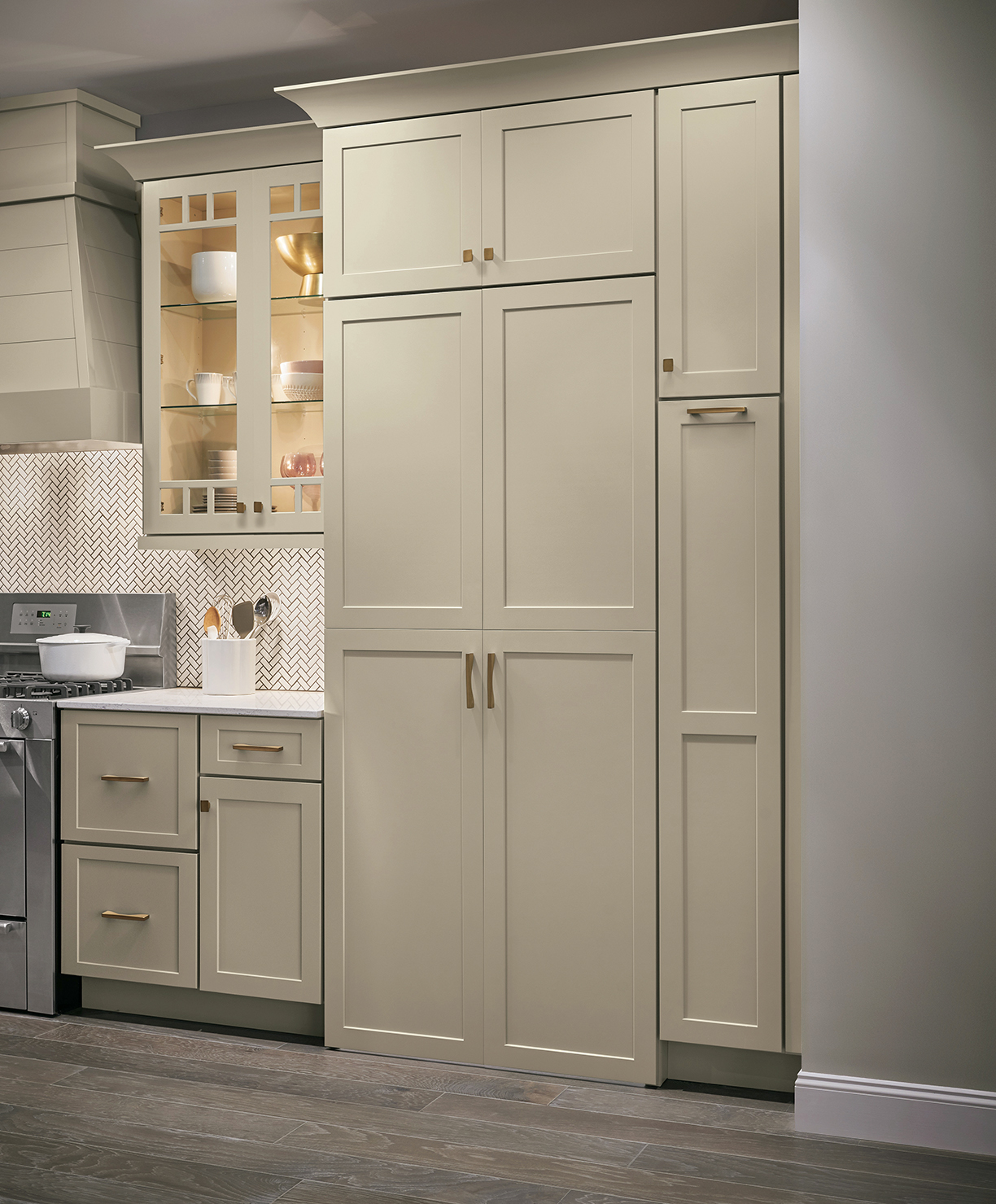
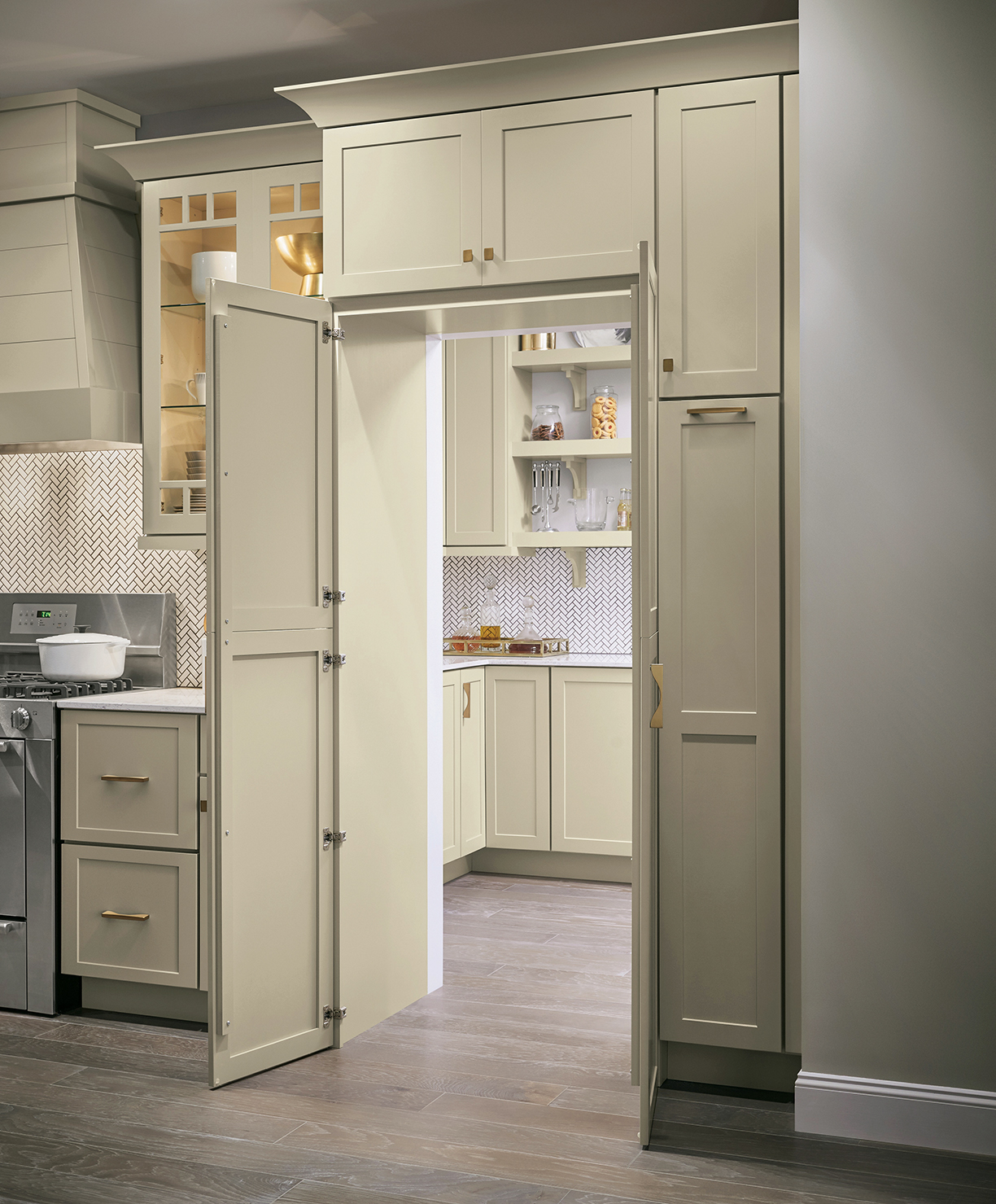
Now you see it, now you don’t. It’s the messy kitchen. Cabinet doors open to a second space for prep, storage and even cooking. Photos courtesy of Masterbrand Cabinets.
For consumers, the timing might be right. Smart-home technology has changed in only a few years, moving from a nice-but-quirky gadget to something worthwhile. “Smart is the new green” was the consensus of a trio of kitchen design exerts speaking at KBIS.
Ryan Herd is a tech veteran, NKBA industry insider and author of Join the Smart Home Revolution. He sees technology finally turning the corner, moving from a nice-to-have gadget to something offering real value to consumers. “Things are knitted together better” is his take on the cur-rent state of technology for the home and also for kitchens. Knitting together refers to ways different applications, devices and even appliances work together to produce outcomes consumers find beneficial. Some, such as the number of cooking apps integrated into appliances (highlighted at KIBS this year), are already in the marketplace. Others are on the cusp of being introduced. Appliance manufacturer Miele introduced Con@ctivity 2.0, which connects an induction cooktop with a ventilation hood. When the cooktop is turned on, the information is transmitted to the hood, which turns on. It continues to run for a few minutes after cooking is completed and then automatically turns off.
Bosch, along with Thermador and Gaggenau, introduced a line-up of voice assistants, all part of their smart, open-platform Home Connect. “All within one app, Home Connect empowers consumers to personalize the way they interact with appliances through any number of our partners and services, such as waking up to a fresh cup of coffee each day when the alarm goes off, setting the lights to flash when the washing machine cycle is finished, or selecting a recipe that will communicate with the oven to ensure it’s utilizing the right program and temperature for optimal results,” said Patrick Palacio, director of innovations for Home Connect. Partners includer Kitchen Stories, Drop and Innit. Chefling is the first AI powered kitchen assistant that provides pantry management, online shopping and recipe instruction.

Photo courtesy of Whirlpool.
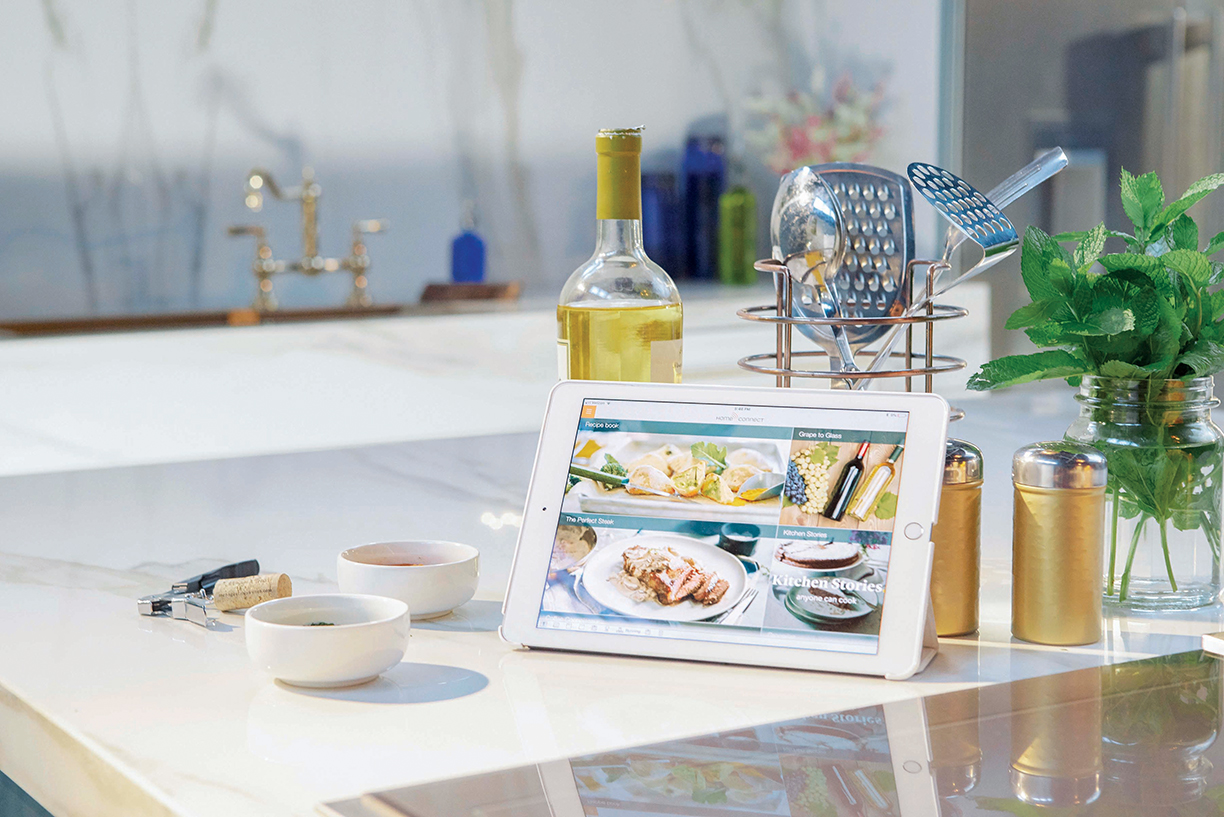
Photo courtesy fo Thermador.
Whirlpool won innovation awards at CES this year, including an innovation award in the Smart Home category for Kitchen Aid’s Smart Oven+, which includes grilling, baking and steaming within one appliance. The KitchenAid App gives status updates, and through the Yummly app users can send cooking instructions directly to the appliance. Voice control via Alexa or Google Home is another innovation.
Designers and manufacturers are look-ing for ways to remove the tangle of cords when multiple devices are being charged. Look for more ways to plug-in, with sockets and charging areas that pop up from countertops or can be installed in drawers. And also to not plug-in, using materials that charge wirelessly, such as a countertop material recently introduced by Corian.
Connectivity also means a manufacturer can detect a problem with an appliance, sometimes even before the consumer does. Herd uses the example of a wine refrigerator that has all the functions one would expect but also includes an app to scan the bottles and maintain an inventory. It has social aspects to facilitate collaboration with friends. The app also enables the manufacturer to monitor the compressor and other mechanical elements and alert consumers (along with scheduling service) if there is a problem, which Herd says is particularly valuable if you are storing $100 bottles of wine.
Winning a top award from NKBA was Flo by Moen, which detects and stops leaks from toilets, showers and faucets, to the pipes in the foundation and behind the walls. Not only does the device alert consumers to leaks, but it can then also turn off the water remotely.
In the not-too-distant future, a smart refrigerator will not only allow you to remotely see what’s inside, it will also keep an inventory that is updated every time something is added or removed. Eventually, cabinets will have a similar capability. “That’s where you get the stitching together,” says Herd. In the next step, the entire kitchen knows everything. Apps will not only keep track of what’s on hand, but they will also make meal suggestions and possibly tailor those suggestions to any specific preferences or even the allergies of guests.
Kitchens and appliances are long-term investments, and some might be reluctant to invest in technology. However, for upscale consumers it’s easy to envision a time when the convenience afforded by technology will far outweigh the cost.
Many contemporary luxury watches are inspired by the sleek aesthetics and seductive instrumentation of the automobile and aerospace industries, resulting in endorsement deals with Formula One drivers and marketing campaigns featuring test pilots. Some of the high-tech materials that make sports cars and fighter jets lightweight and aerodynamic are now incorporated into watches.
For many consumer products, there is a correlation between weight and value, a concept manufacturers have, sometimes misleadingly, reinforced. Watchmakers, whose sleek, svelte products have evolved into large, chunky ornaments per current style, have been forced to explore the use of lighter materials. Now the ethereal is being equated with value, and the race to lightness has produced some remarkable products.

Astronaut photo courtesy of NASA; Watch photo courtesy of Roger Dubuis.
Several lightweight watches later, Richard Mille introduced the RM 50-03 McClaren F1 model in 2017, a limited edition of 75 pieces priced at $980,000. At less than 40 grams (including the strap), it became the world’s lightest split-seconds chronograph tourbillon watch. That product introduced a new nanomaterial called graphene (aka Graph TPT) that is 200 times stronger than steel but far lighter. Noting watchmakers’ proclivity to mimic machines on the race track, Adams suggests, “Timepieces are often referred to by modern watchmakers, including Richard Mille, as ‘race cars for the wrist.’”
Lightweight materials like carbon fiber and titanium have been adopted by manufacturers of mass-produced watches, brands such as Citizen and Casio, but luxury watchmakers are consistently pioneering newer, lighter materials. The carbon nano-fibers employed by Richard Mille are similar to what are used for the U.S. Air Force’s stealth bombers, and graphene is being tested by McClaren for its Grand Prix race cars. “I’ve worn many lightweight Richard Mille watches and they’re very cool,” reports Adams. “The irony is that the more lightweight they are, the more difficult it can be to present them as the mega-luxury products their prices suggest,” he adds.
Ariel Adams, whose A Blog to Watch is a leading resource for watch enthusiasts, reports, “Watch brands typically are poor at selling anything new, and thus rely on other products and industries who have already created an appetite for particular materials or themes.” He cites comfort as a prime motivation for reducing weight, stating, “There’s a very real reason why a collector might prefer to wear a watch that’s barely noticeable as opposed to a ‘gold brick on the wrist.’”
Nancy Olson, managing editor at Inter-national Watch (iW) magazine, reports, “It’s all about expanding the limits of development and design to set themselves apart within a somewhat crowded watch market, as well as, in this instance, sturdiness and comfort—particularly in the sport watch arena.” Richard Mille, arguably the trendiest brand in watches, is particularly influential in sport-themed design.
At the French Open in 2010 Richard Mille debuted the RM 027 tourbillon watch, a limited edition designed for tennis superstar and brand ambassador Rafael Nadal. Able to withstand the violent gravitational forces he produces on the clay court, the watch weighs a mere 19 grams (0.670 ounces) with its strap, thanks to a carbon-based composite. The entire movement, crafted from titanium and a high-lithium content alloy — the light yet durable lithium is used in aircraft, rockets and race cars — weighs just 3.83 grams (0.135 ounces).
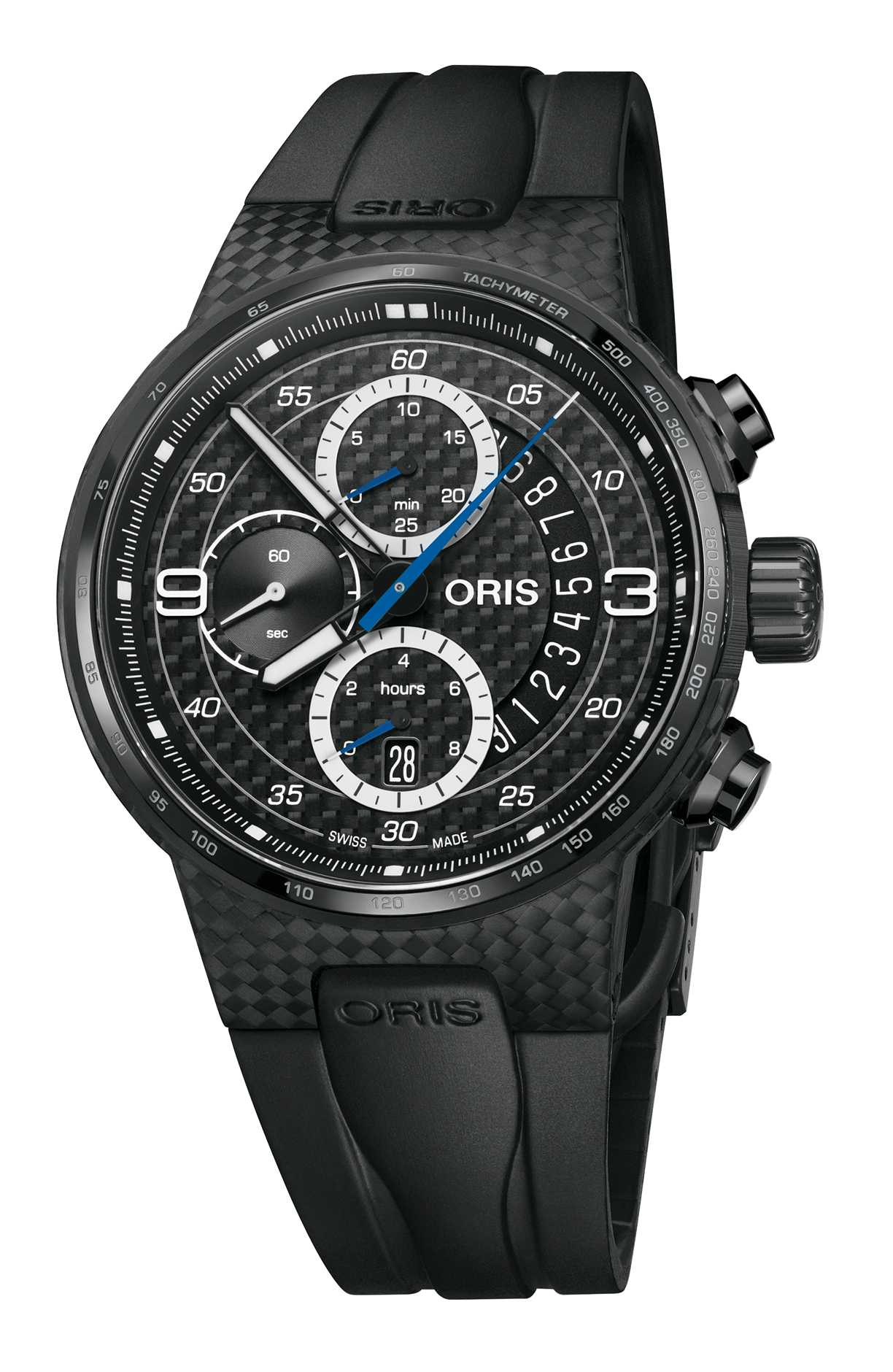
Oris Williams FW41: Limited Edition. Photo courtesy of Oris.
Richard Mille is not the only manufacturer with a connection to auto racing, and the FW41 from Oris is part of a racing-themed collection that celebrated the Williams Team’s 41st season on the Formula One circuit. The total weight of this limited edition watch, comprised largely of carbon fiber and titanium, is not disclosed but the middle case weighs in at only 7.2 grams (0.254 ounces).
Known for capitalizing on trends set by more expensive watchmakers, Oris brings greater accessibility to feather-weight watches, as the FW41 costs approximately $4,350. With its patterned black carbon fiber dial, the FW41 has a dark, sultry aesthetic, reminiscent of the aircraft that share the same materials. Roger Dubuis, which frequently collaborates with iconic racing brands Lamborghini and Pirelli, uses carbon and titanium to lighten its skeleton-style Excalibur Spider watches, both an automatic model and flying tourbillon.
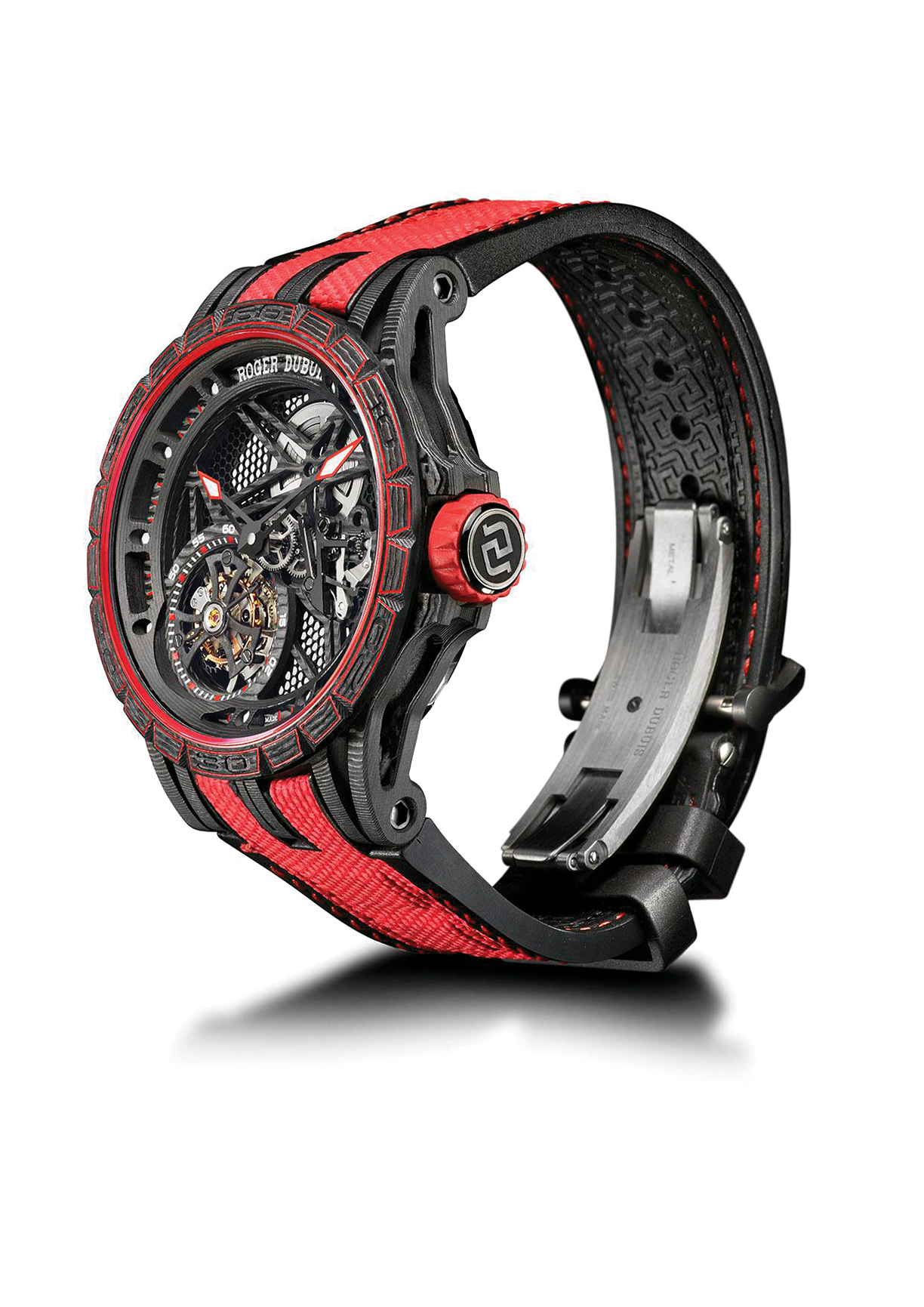
Excalibur Spider Carbon Skeleton: Flying Tourbillon RD509SQ. Photo courtesy of Roger Dubuis.
Montblanc, the legendary German manufacturer of writing instruments, is also a superb watchmaker and in 2016 it released a concept watch, the Time-Walker Pythagore Ultra-Light that weighed in at an extraordinary 14.88 grams (0.525 ounces) sans the strap. Montblanc achieved this lightness through skeletonization and the use of mineral glass, titanium and a Swiss composite material charged with car-bon nanotubes called Innovative Technical Revolutionary Resin.
For those who value a thin profile even more than lightness, the crown would go to Bulgari, which at Baselworld 2019 — the celebrated timepiece/jewelry exhibition held in Switzerland every spring — debuted the thinnest automatic wristwatch in the world. The venerable Italian brand has long specialized in ultra-thin watches and with a 3.3mm movement housed in a case just 6.9mm thick, Bulgari’s razor-thin Octo Finissimo Chronograph GMT is the company’s latest achievement in condensing complex mechanisms.
Ariel Adams cautions that thin watch engineering differs from lightweight watch engineering in significant ways. “Thin watches tend to be a lot more diffcult to make because you aren’t just working with materials but also tolerances and moving parts that need to go next to one another,” he explains. While the Octo Finis simo secures a new title for Bulgari, Piaget (another specialist in slender timepieces) holds the record for mechanical watches. “While thin watches can also be lightweight, appreciating the effort that’s required to make them is an entirely different discussion,” insists Adams.
Nancy Olson, who professionally observes the often-fickle trends in watch-making, does not dismiss the flight-to-light or thin-is-in movements. “A trend always leaves something behind, even when the expression of it evolves,” she states, adding, “Every milestone in watchmaking changes the whole in some way.”
Light & Lean
Bulgari- www.bulgari.com
Montblanc- www.montblanc.com
Oris- www.oris.ch
Piaget- www.piaget.com
Richard Mille- www.richardmille.com
Roger Dubuis- www.rogerdubuis.com
Resources
A Blog to Watch- www.ablogtowatch.com
International Watch- iwmagazine.com
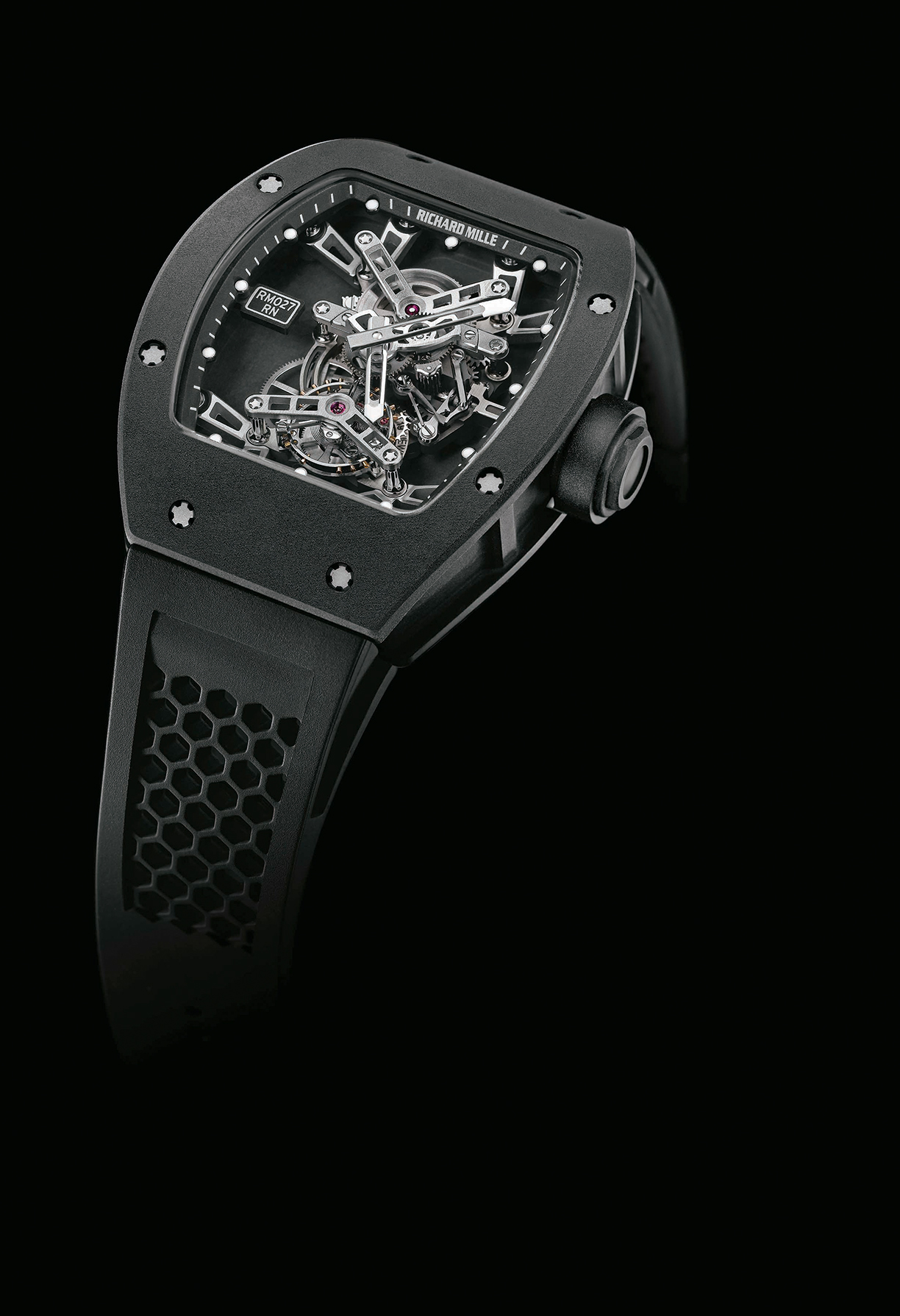
Richard Mille RM 027 Tourbillon – Rafael Nadal.
Photo courtesy of Richard Mille.

The Run To Ibiza
Roger Dubuis has created “The Run To…,” a series of extraordinary supercar adventures, with the signature drive concluding at the Monaco Grand Prix. Participants pass through unrivaled natural beauty in the world’s finest automobiles, enhanced with fine cuisine, lavish accommodations and world-class entertainment. The glamour of these journeys fuel the company’s inspired watchmaking. Photo courtesy of The Good Life Inc.
Surfing has always been one of the most approachable, laid-back sports in the world, with no cost to entry beyond access to a public beach, a second-hand board and a pocketful of change for an after-wipeout fish taco. But with iconic luxury brands like Louis Vuitton and Hermès creating boards for their exclusive clienteles, another side to the sport has emerged.
Among the most striking boards available are those from Haleiwa Surfboard Company, at which septuagenarian surfer and veteran artisan Mahlon (“Lon”) Klein typically crafts no more than 15 exquisite wooden boards per year. Located on Oahu’s North Shore, one of Hawaii’s most storied surfing destinations, Haleiwa incorporates indigenous hardwoods such as koa, mango, kamani, and monkey-pod into its unique boards.
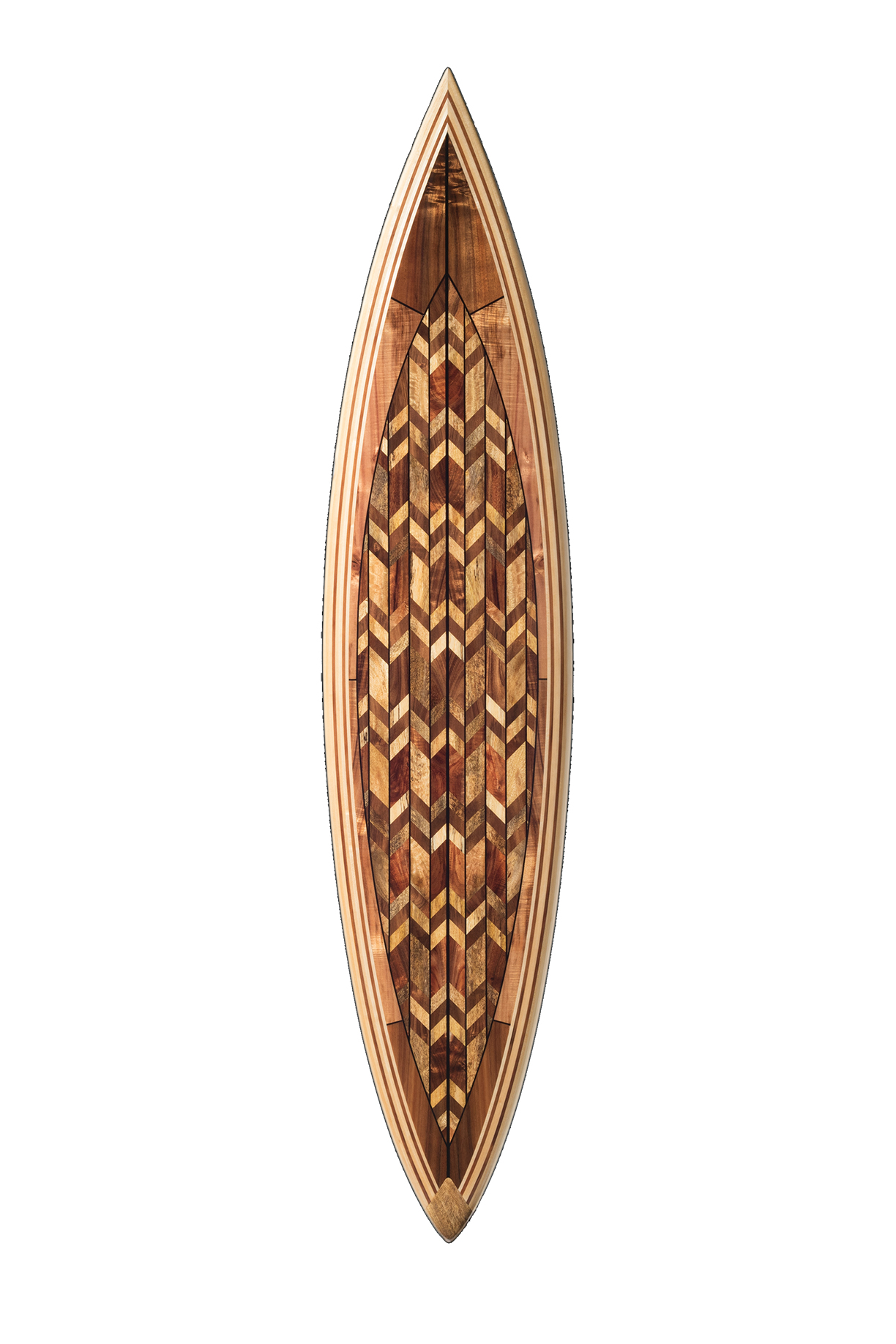
#68: Hand-crafted by: Lon Klein @ Haleiwa
Dimensions: 7′-3″ X 18 1/2″ X 2 5/8″
Surfboard Company Deck: Koa, mango
Shape Design: Dick Brewer Bottom: African mahogany
Photo courtesy of John Bilderback.
Klein originally began crafting boards from lightweight woods, and some are used to this day by pro surfers Michael Ho and Roger Erickson, but he eventually sought out more attractive woods that are too heavy for competitive surfing. “My audience was no longer the surfing market but the art market,” explains Klein, who insists no two of his boards are alike. “I never thought of myself as an artist,” says the native Californian who moved to Hawaii for the surfing. “But I’m always trying to accentuate the beauty of the shape itself,” he adds.
Klein says that more than 200 hours of labor go into each handcrafted, triple-gloss-finished board, and the artisan has no interest in compromising his craft for mass-production. Haleiwa Surfboard Company’s worldwide following includes clients from Europe to Japan, and Klein reports that a member of the Moroccan royal family purchased a pair of the wood-clad “sticks.” The firm’s larger surf-boards are currently priced at $22,000 while a shorter ver-sion commands $14,000.
Far from the iconic beaches of Hawaii or California is England’s LUX Surfboards, a collaboration of Ellie Miller, the only female professional board maker in Europe, and artist Danni Bradford. “The Aureus,” is their ’70s-inspired board, entirely sheathed in 24-karat gold leaf and currently priced at the equivalent of $45,600. The deck features a triple elliptical pinline design and the hull includes a single gilded fiberglass fin.
“A 24-karat gold surfboard had never been made before, and we were inspired by how unique it would be if we could achieve it,” says Bradford, whose studio is close to her favorite surfi ng spot in North Devon. “I’ve been riding Ellie’s surfboards exclusively for the last six years, and watching her grow as maker,” says Bradford, who adds, “It seemed only natural for us to combine our skills.”
“The board took months to complete, and it was incredibly painstaking,” says Bradford, who explains the gold was integrated into the construction of the board, not simply applied to the surface. The artist, acclaimed for her imaginative work with glass, says of her partnership with Miller, “I definitely think we’ll collaborate again on another board.”
In Los Angeles, designer Elisabeth Weinstock covers everything from handbags to soccer balls in exotic anaconda or boa skins. Her surfboards ($5,600), clad in snakeskin or other exotic leathers, are popular even with people who never venture into the waves. “Whether you’re a surf enthusiast or just appreciate the California beach vibe, this is the ultimate luxury objet d’art,” says Weinstock, who notes, “It was designed for the lover of the art of the sport.”
Kelly Wearstler, a prominent L.A. interior designer known for her trendy Holly-wood Regency- or Art Deco-in-spired hotel commissions, has also waded into surfboard design. Handcrafted from shaved Russian birch and sealed with surf resin, her $8,900 boards display compel-ling patterns, some organic and others more structured, that bring artistic expression to the sport. While you could conceivably paddle out on one of these glossy boards, they are primarily decorative, designed to bring the spirit of surfing indoors. Wearstler reports they were inspired by her love of the Malibu beach culture.

Photo courtesy of iStockPhoto.com/EpicStockMedia.
Hawaiian artist Tim Nguyen, whose idyllic images of his fellow Islanders are expressed with rich tropical colors reminiscent of Impressionist painter Paul Gauguin, presents his love of the Aloha State on a surfboard. His “Under Banana Leaves,” currently offered at specialty retailer Martin & MacArthur for $8,190, is the ideal piece of décor for a luxury Hawaiian estate — or even a Chicago penthouse whose owner yearns for the Maui sun.
“Art on surfboards is my expression of Island beauty, my passion for the ocean and the depiction of Hawaiian culture,” says Nguyen, who resides on the tranquil, unspoiled west side of Oahu where local traditions endure. “My board represents a scene in my imagination about a lush tropical garden,” reports the artist, whose frequent images of banana trees capture the magical qualities of Polynesian culture.
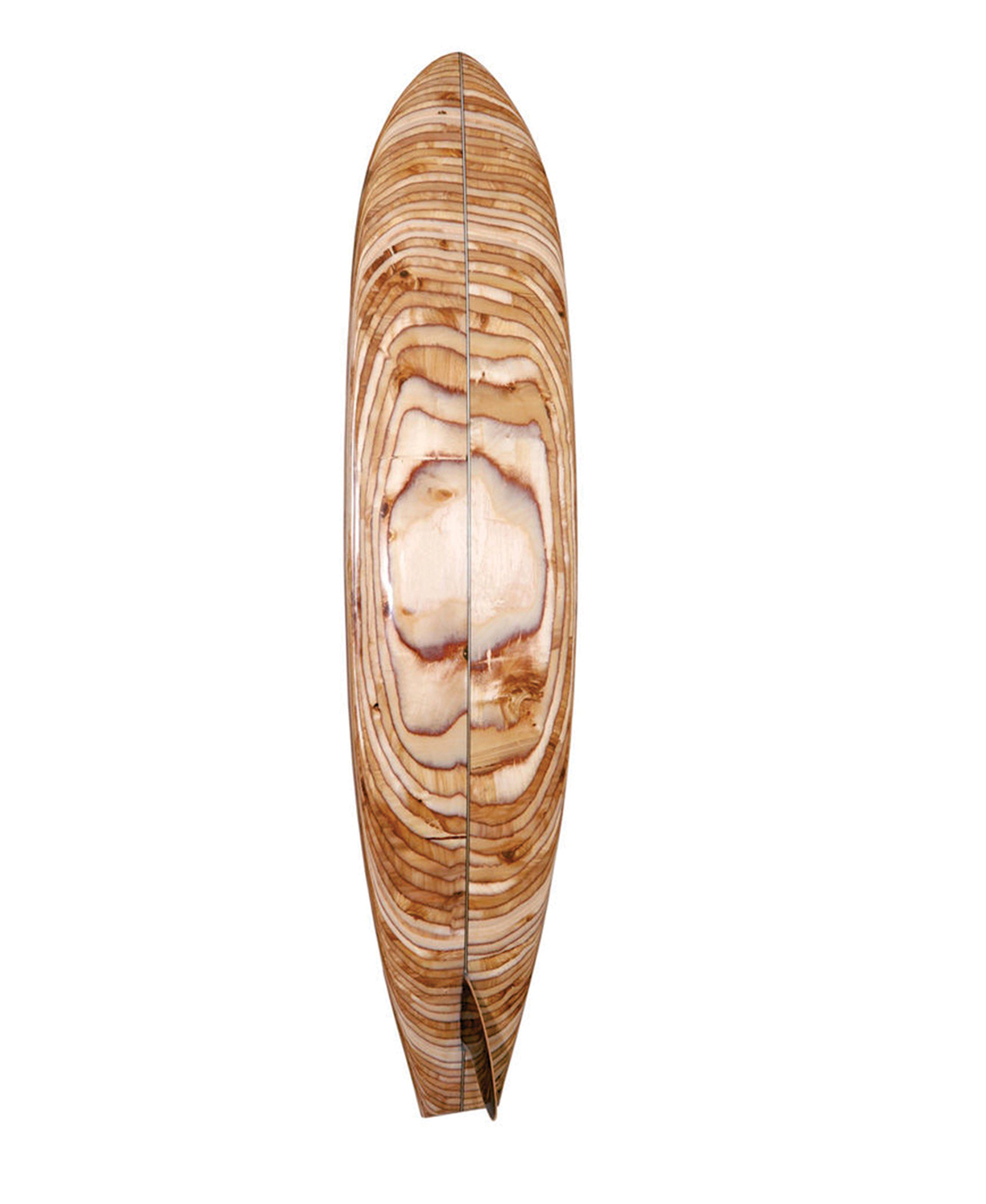
Russian Birch Board by Kelly Wearstler. Photo courtesy of Kelly Wearstler.
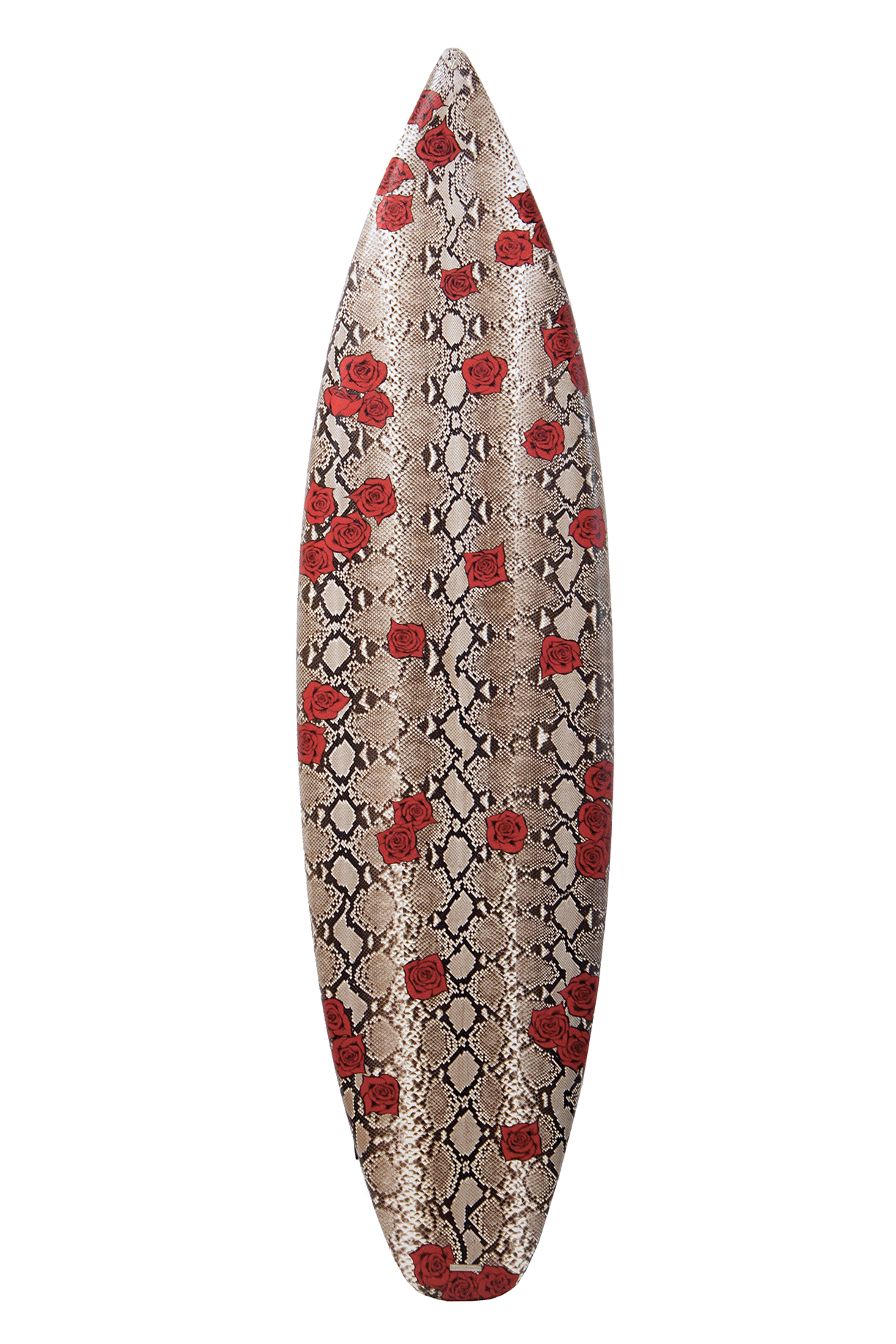
Roses surboard from Elizabeth Weinstock. Photo courtesty of John Milios.
The most expensive surf-board on record was created by New Zealand designer Roy Stuart in 2014 and priced at $1.3 million. The board, named “Rampant” was crafted from paulownia, an Asian tree known for lavender-colored blossoms and has a 23-karat gold lion emblem engraved into it. The hull of the board has a unique tunnel-shaped fin created from kahikatea wood, a towering tree native to New Zealand, along with a distinctive neon blue polycarbonate fin for further balance.

The Aureus by LUX Surfboards. Photo courtesy of M. Corker / Shimnix Films.
In addition to iconic fashion labels delving into surf culture — Chanel currently offers an elegant board for $8,900 — auto manufacturers like Peugeot and Tesla have also applied their distinctive style and engineering to the once-pedestrian boards. Mercedes-Benz created the “Silver Arrow of the Seas,” an aerodynamic carbon-fiber board with the sleek good looks of a sports car, tailor-made for monster wave master Garrett McNamara. In 2014, the legendary surfer used the board to ride some of the most enormous waves on record off the coast of Nazaré, Portugal.
Sophisticated Sticks
Elisabeth Weinstock
www.elisabethweinstock.com
Haleiwa Surfboard Company
www.haleiwasurfboards.com
Kelly Wearstler
www.kellywearstler.com
LUX Surfboards
www.luxsurfboards.com
Martin & MacArthur
www.martinandmacarthur.com
Homes grouped around a small collection of shops, churches, banks, a doctor’s office and a barber. It’s the way cities and towns developed. Today, a similar process is underway in Vancouver, Miami, Baltimore, San Jose, Memphis and many other cities, except expansion is as much upward as it is outward in a new vision of community considered a “vertical village.”
The concept found early proponents in Asia, where space is at a greater premium. Now, similar neighborhoods are taking shape in the U.S. and Canada, often in former industrial or commercial sites. In Memphis, Cross-town Concourse is rising in a former Sears distribution center and retail outlet the size of 25 football fields. In Atlanta, another abandoned distribution center is the foundation for Ponce Market, a mixed-use community adjacent to the Beltline. And in an era when retail seems to be threatened, shopping malls — not the familiar single-dimension covered expanse, but open sites inviting participation — are the foundation for vertical villages along with a mix of residences in multiple buildings and varied price brackets.
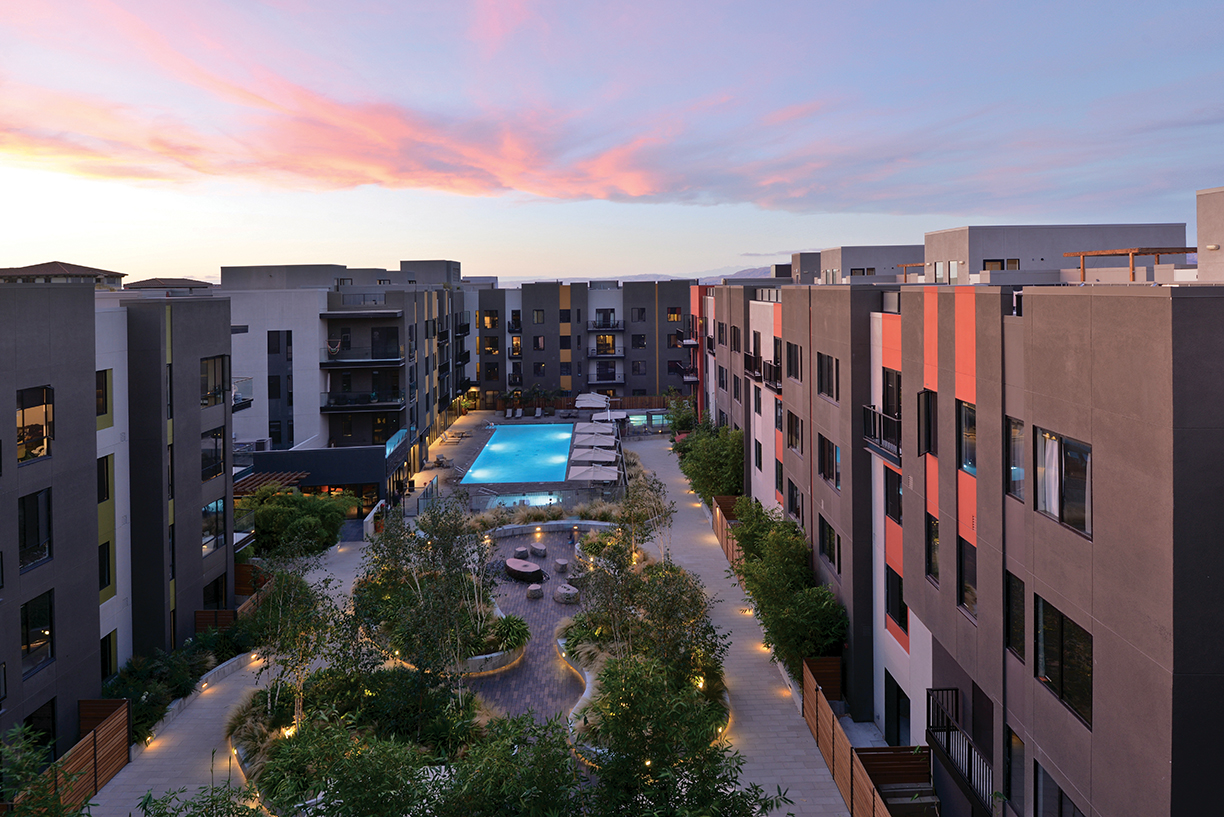
Misora Santana Row. Photo courtesy of Ankrom Moisan Architecture.
However, no matter how well meshed, retail and residential alone do not create community. Instead, the addition of parks, trails, green spaces, grocery stores, farmer’s markets, performance centers, galleries, venues for the arts, wellness, education and medical and dental facilities turn what might be simply a new mall into a community.
Arts and culture are a focus at Crosstown Concourse, which is a collaborative effort, focused on the arts. Here, residents are perceived as embodying the spirit of the place.
Santana Row in West San Jose, California, is another relatively new mixed-use community incorporating retail, offices and residential.
“Community is engrained in everything we do here at Santana Row,” says Collette Navarrette, West Coast marketing director for the developer, Federal Realty Investment Trust. “The center-wide amenities, highly engaged residents, and unique community events that Santana Row offers inspire and connect people in a meaningful and lasting way.
The concept of a vertical village might be mainstream for developers, but it’s still new to consumers. One of their biggest questions is whether the convenience and community will meet their needs and most especially their values, according to data scientist David Allison, who heads an eponymous global advisory firm. He says it all comes down to values. “What we value determines what we do.”
Allison brings new insights into con-sumer behavior. He contends traditional demographic parameters of age and gender do not work in today’s market. “People really don’t act their age anymore. Gender rules and norms are less important than ever before. In fact,” he says, “we live in a post-demographic era. Allison’s firm has amassed data from almost half a million people regarding 40 core human values as well as several hundred other needs, wants and expectations. Their database, Valuegraphics, shows that people in the traditional demographic categories have little agreement — only 13 percent of the time for Boomers, 11 percent for Gen X and 15 percent for Millennials. Humans overall only agree 8 percent of the time. Instead, Valuegraphics data uncovered 10 huge groups or architypes who agree on pretty much everything.
To profile those drawn to a vertical village, Allison combined this data with additional research among 1,864 North Americans who indicated interest in such a community. The results reveal several major interest profiles.
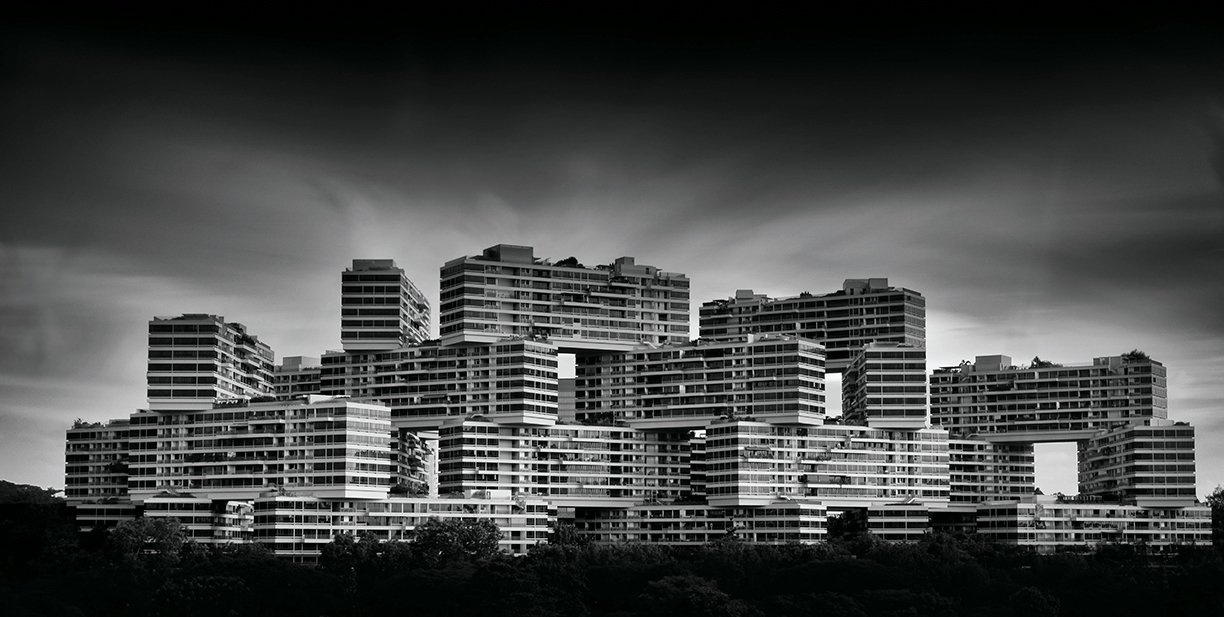
The Interlace in Singapore, designed by Ole Scheeren and Oma, established a new vision for urban residential living. Photo courtesy of Mike Cartmell.
Local Experience
Chasers Approximately 32 percent literally pursue experience after experience, but they like to have those experiences close to home. “They want to do things they love again and again,” says Allison. Loyal to things that trigger a sense of belonging, they are apt to join a team or club and love to see the same faces. Quality of life often means quality of social life. A sense of belonging is important and they like the idea of multipurpose living. Allison says for this group extra thought should be given to programming. A 3D walkthrough of a yet to be finished building would have great appeal.
Workaholic Investors
Comprising 19 percent of potential residents, this group values financial security, material possessions and wealth. They are likely see a place in a vertical village as an investment. Allison says, “They are thinking long term about all of the component parts of the offering.” They are likely to be attracted to the proximity of amenities. Who lives in the building could also be an incentive for them.
Creative Savers
This group, which comprises about 16 percent of the sample, gravitates to places that will foster their own creativity. They accept potential financial challenges presented by a creativity-centered life. They are likely to have children and are attracted to inspiring design, cozy common areas and quaint trails meandering through parks, according to Allison.
City Loving Environmentalists
The last of the major archetypes, this group sees this style of community as being better for the environment and is motivated to reduce their carbon footprint. They love city living but appreciate and value of parks and green spaces. Highly educated and loyal, they are attracted to diversity. Family and relationships as well as health and wellbeing are also important to them.
Another group, about 18 percent of the sample, is composed of varied smaller architypes, which indicate going vertical might represent a substantial cross section of consumers.

CityVista, a mixed-use development, located at 475 K Street, N.W., in the Mount Vernon Square neighborhood of Washington D.C. Photo courtesy of Creative Commons by AgnosticPreachersKid.
These high-end, luxe speakers and audio consoles specifically for music lovers and audiophiles will make you feel like you’re listening to your favorite band rockin’ out at an ampitheater live, or let you experience your classic vinyls with authentic, high-performance sound. It’s time to hear what exceptionally engineered design and and audio quality can do for your home music listening experience.
Renaissance ESL 15A by MartinLogan, $25,000 a pair
The flagship model in MartinLogan’s Masterpiece Series of high-end electrostatic (ESL) speakers, the Renaissance ESL 15A, is a revolutionary step forward in terms of performance, technology and design. Since 1983, MartinLogan has handcrafted speakers featuring electrostatic and thin-film technologies, achieving the ultimate in audio realism. Renaissance’s 15-inch-wide and 46-inch-tall electrostatic panel reproduces sound with unfl inching accuracy and is married to a pair of amplified high performance 1,000-Watt powered woofers which can deliver powerful bass sound. “The experience of listening to an electrostatic speaker for the first time is often described as transformative,” says Devin Zell, Martin Logan Marketing Manager. “If you set aside all of the evocative technology, close your eyes, and listen, these speakers disappear and transport a listener deep into the heart of music — accessing a shockingly intimate and emotional connection to the music and performers.”
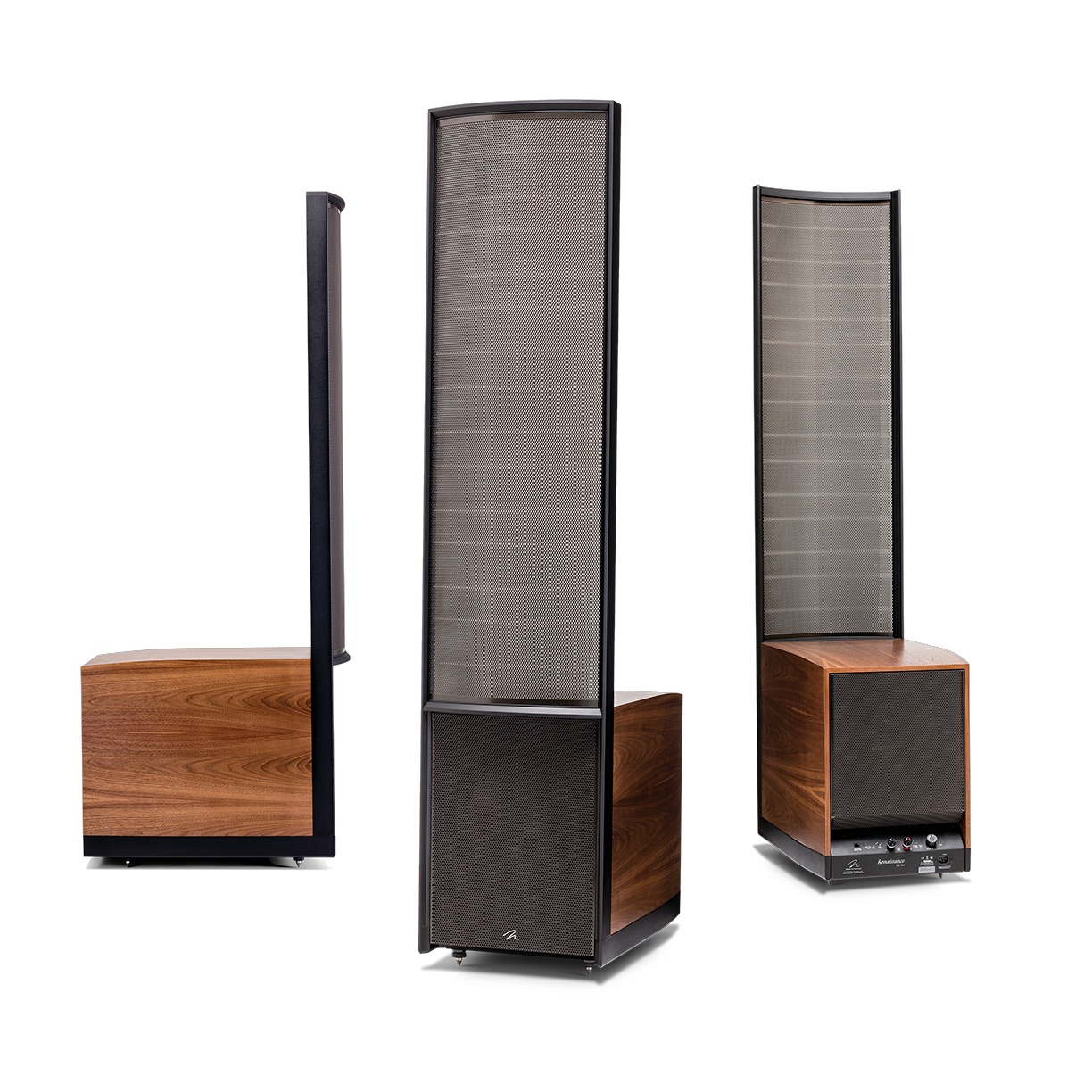
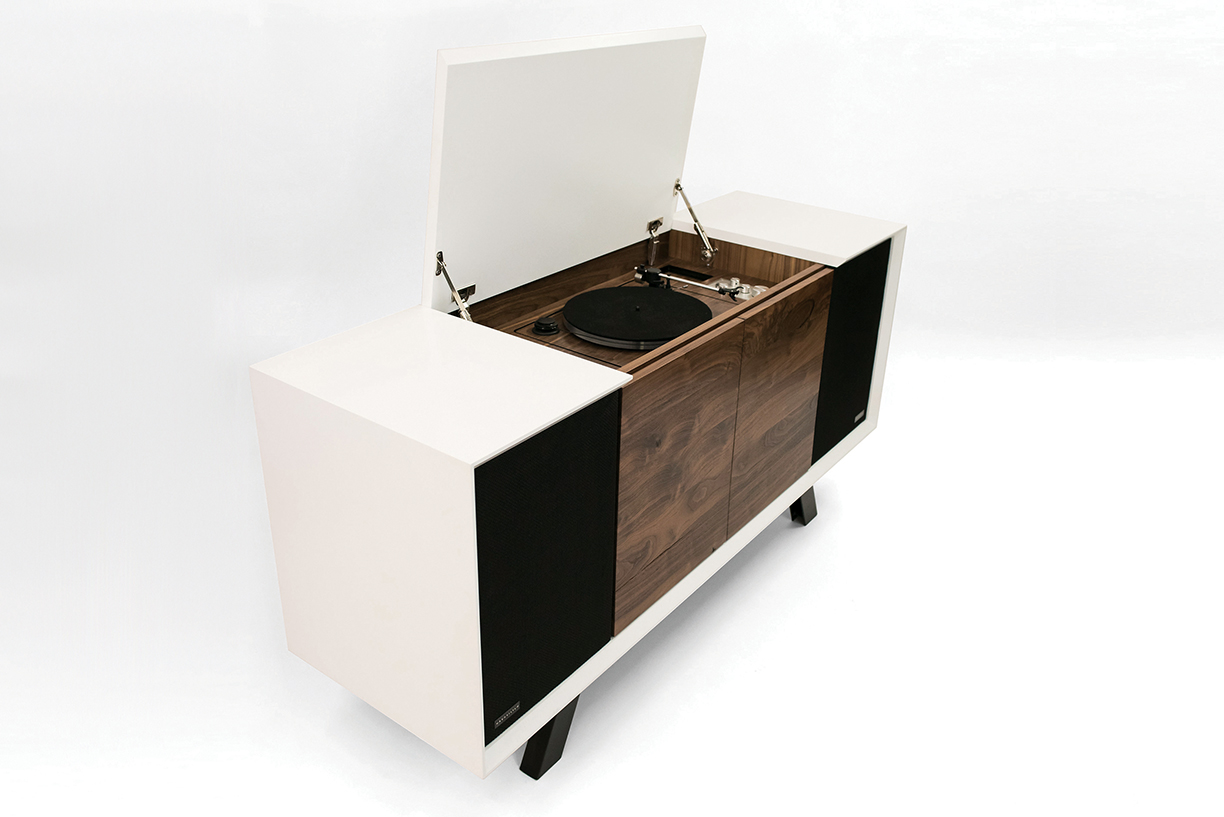
Sonos Edition Console by Wrensilva, $5,000
“We wanted to design something specifically for smaller urban spaces,” says Debra Sayler, Chief Design Officer of Wrensilva of the Sonos Edition Stereo Console. “Something that combined natural elements, such as gnarled wood grain, and the clean, urban lines in the welded steel legs and crisp white outer finish.” Based in San Diego, California, Wrensilva was founded in 2016 by Sayler and her husband Scott. Together, they create modern stereo consoles dedicated to “reawakening the spirit of hifi.” Their mission of time-honored design combined with advanced audio technologies materialized in their collaboration with Sonos for this custom piece. In this console, Sonos speakers are incorporated into curved walnut enclosures. “We wanted to highlight the speakers’ curves, not disguise them. On the technology side, we incorporated a wirelessly synced volume knob that communicates directly with the Sonos app. This is a neat feature for Sonos users that are craving a more traditional analog experience.”
Persona 9H by Paradigm, $35,000 a pair
Persona 9H, Paradigm’s most ambitious design to date, leverages the company’s 34 years of acoustical development and innovative design. The speakers were developed out of research to explore the limits of audio engineering, and the results were staggering — an entire line of high-end loudspeakers utilizing cutting-edge concepts. The flagship line showcases vanguard materials such as the utilization of Truextent® Pure Beryllium, a rare chemical element, in the drivers to deliver high-resolution detail, depth and dynamics. While the use of Beryllium in the construction of the tweeters is not unheard (it has a “cult” status for the most expensive of audio equipment), the use of it in both the tweeters and mid-range divers is unique to Persona. The Persona 9H is not only the perfect speaker for audiophiles craving exceptional performance, but also for those seeking luxurious levels of fit and finish — available in 23 premium automotive finishes.
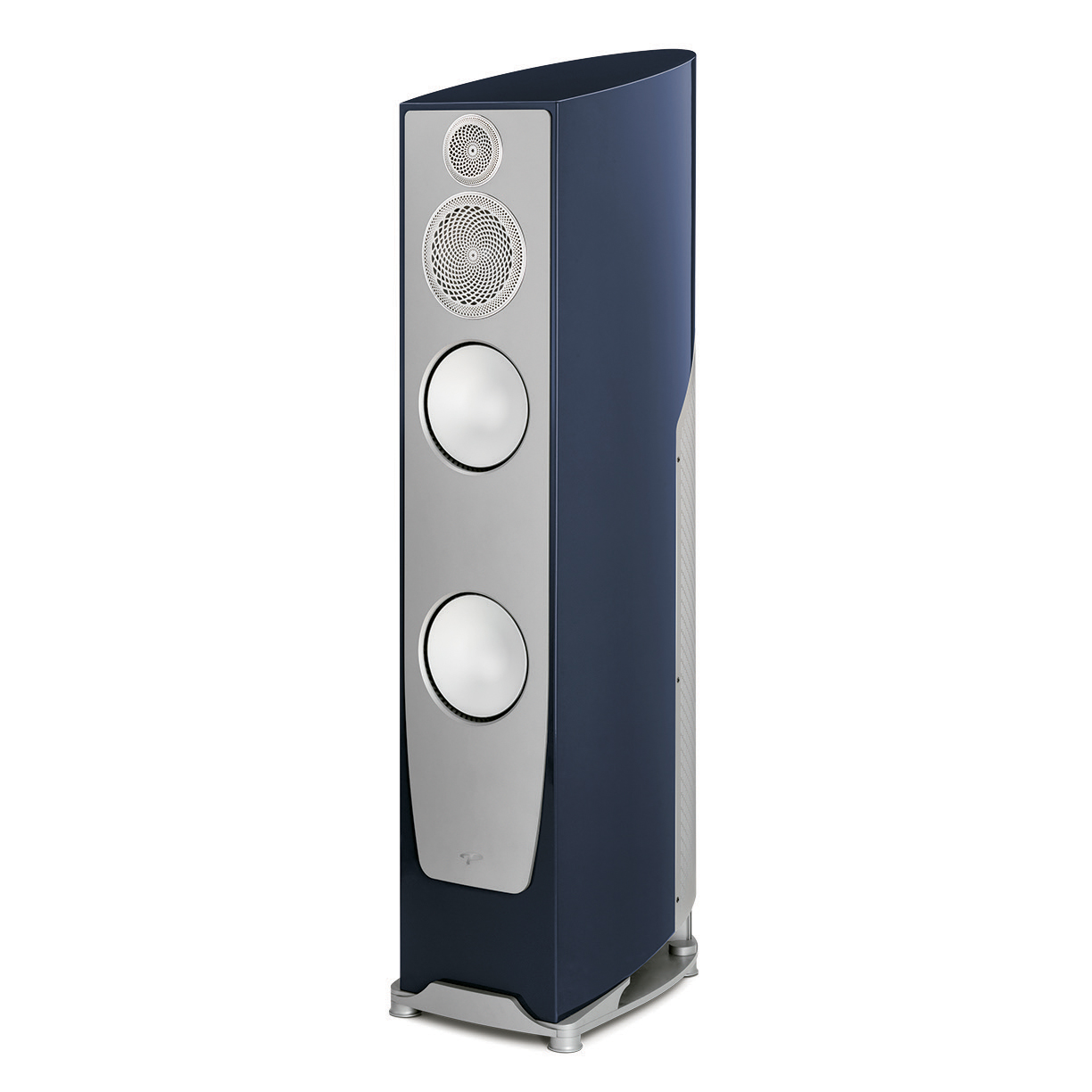
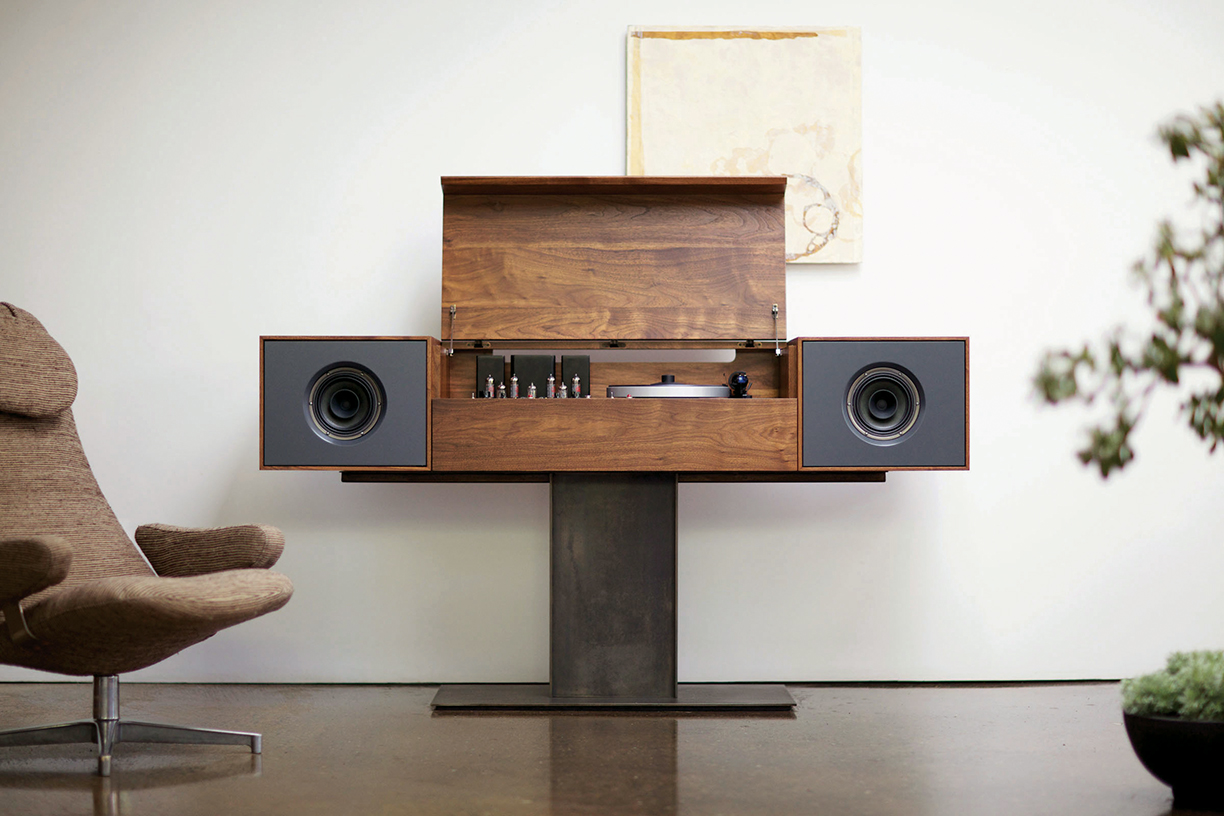
Modern Record Console by Symbol Audio
The Modern Record Console by Symbol Audio pays homage to the “all-in-one” HiFi consoles of the 1950s, integrating “old school” electronics with modern wireless capabilities. Since 2012, the company has been creating products for music lovers who value thoughtful craftsmanship in their audio home furnishings. With a mission to enrich the connection between the listener and their music, the Modern Record Console combines technology with traditional analog electrics into a beautiful piece of handmade furniture crafted from solid American Walnut wood. The sleek design makes this piece a focal point of any space. Lift the lid to expose a hand-built tube amplifier and turntable set into patinated steel plates that delivers a warm, pure signal to two 6.5” full-range speakers. Tucked out of view in the metal base is a second amplifier and subwoofer made to extend low-end frequency and add richness to any sound. Switch the selector from turntable to WiFi to stream from any digital source to control music selections.


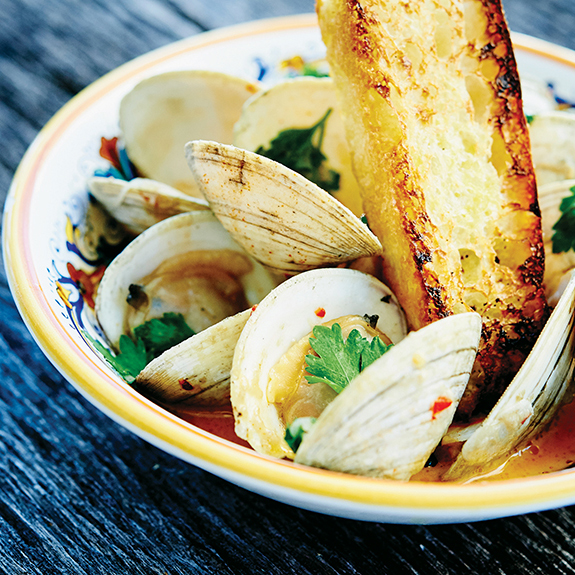
It may lack the culinary notoriety of San Francisco, New Orleans or the Big Apple, but St. Louis has quietly been developing a serious food scene. In addition to benefitting from a large Italian-American community and a geographic flirtation with the South, talented young chefs from around the country are arriving. Largely responsible for St. Louis’ dining renaissance is chef and prolific restaurateur Gerard Craft.
Craft, who grew up in Washington, D.C., opened his first restaurant in St. Louis knowing very little about the city except that it offered affordable space for a struggling 25-year-old chef. That restaurant, Niche, ignited the local dining scene and his Niche Food Group now operates five restaurants in the Gateway City.
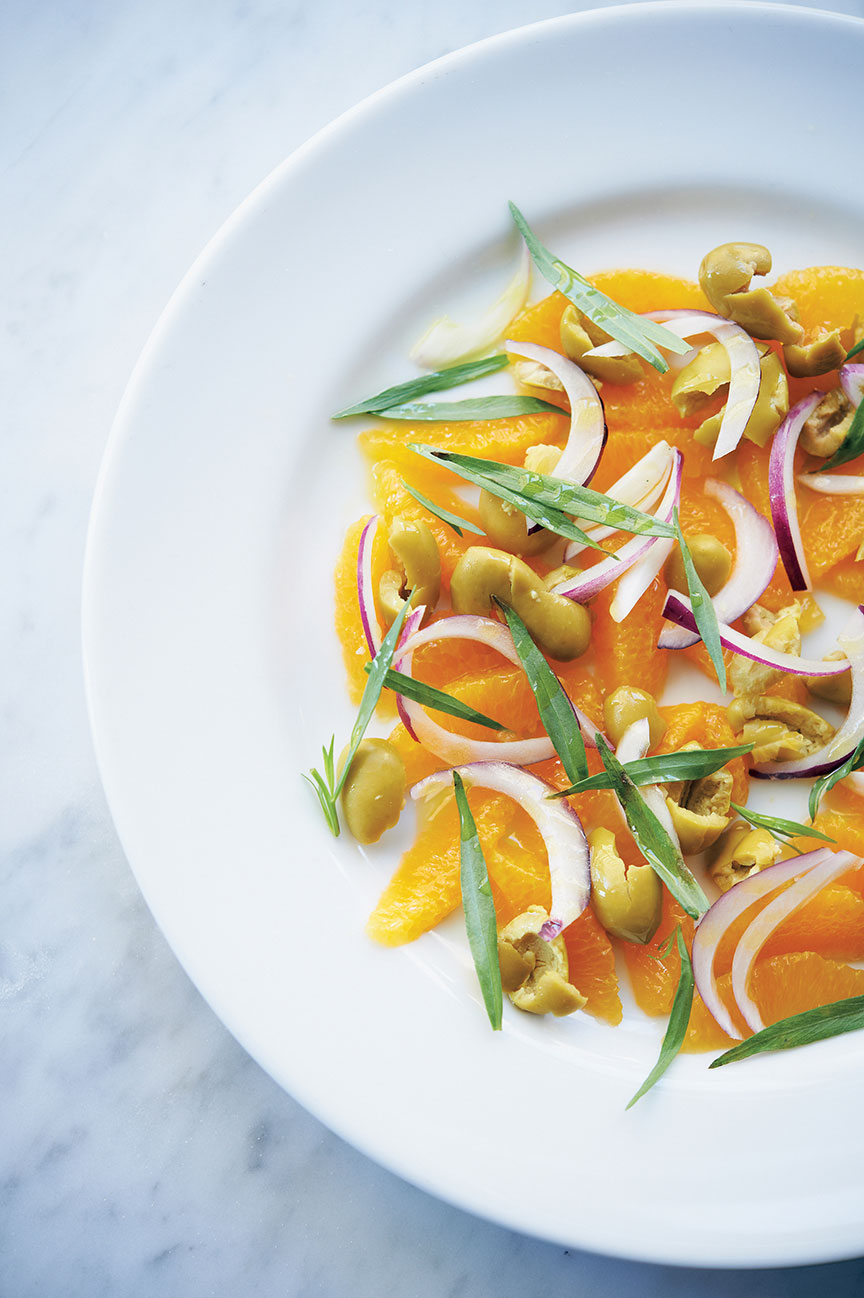
“I still wasn’t that interested in food, but fell in love with the kitchen’s energy, comradery and instant gratification. “I loved the idea that you could produce something, serve it and see the impact it has on people, then clean up and move on to the next day,” recalls the young cook. After spending some time in France, even enrolling in a work-study program at the Ritz in Paris, Craft was feeling confident enough to talk his way into a line cook position at Park City’s well-respected Bistro Toujours.
“It was a disaster,” reports Craft, explaining, “The chef sat me down and told me I had no skills and that I could either leave or work as a prep cook in the basement.” Now recognizing this as a turning point in his career, Craft says, “Being demoted was the best thing that ever happened to me. After I got some hands-on experience down in the basement, I was able to work my way through every station on the line.” After an apprenticeship at the upscale Ryland Inn in New Jersey, Craft earned a sous chef position at Chateau Marmont, a celebrity haunt on Los Angeles’ Sunset Strip.
Hearing that prominent chef Larry Forgione and some other talented chefs had opened restaurants in St. Louis, Craft flew there to look at an old wine bar for a potential restaurant of his own. “It had boarded-up windows, a dirt floor and no electricity,” recalls Craft, who took possession of the space in February 2005 and reopened it as Niche later that year.
Craft had little interest in cooking as a young boy, recalling, “My family was really into food, but I was probably the pickiest eater in the world.” Despite that self-characterization, Craft’s most meaningful food memories revolved around the cooking of his Brazilian nanny. “She was like a second mom to me, and I grew up eating simple, rustic Brazilian food like black beans and feijoada,” says Craft, who adds, “She had such a touch with food and was able to make anything taste great.” He honored that influential nanny by offering contemporary versions of pão de queijo (Brazilian cheese bread) and brigadeiro (confection) at Niche. “Having her visit the restaurant before she died was a big moment for me,” says Craft.
As a kid, Craft’s heroes were not Wolfgang Puck or Emeril Lagasse but Russell Simmons and Richard Branson, as the fledgling entrepreneur sold paintballs to classmates in fifth grade, a clothing line in high school. He attended Westminster College in Salt Lake City, a choice driven by his passion for snowboarding, but dropped out after two years. To supplement his income as a snowboard photographer, Craft began washing dishes and cooking at a local diner.
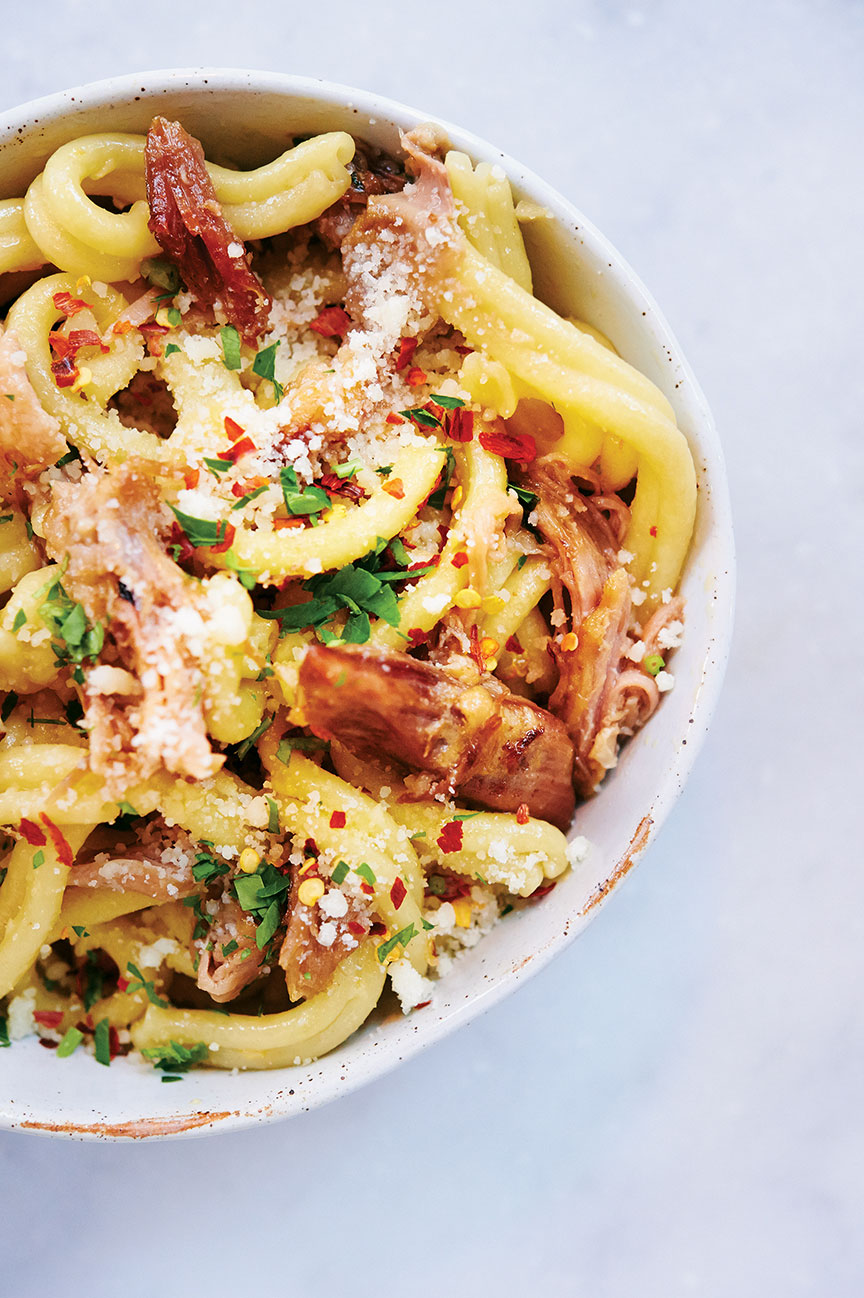
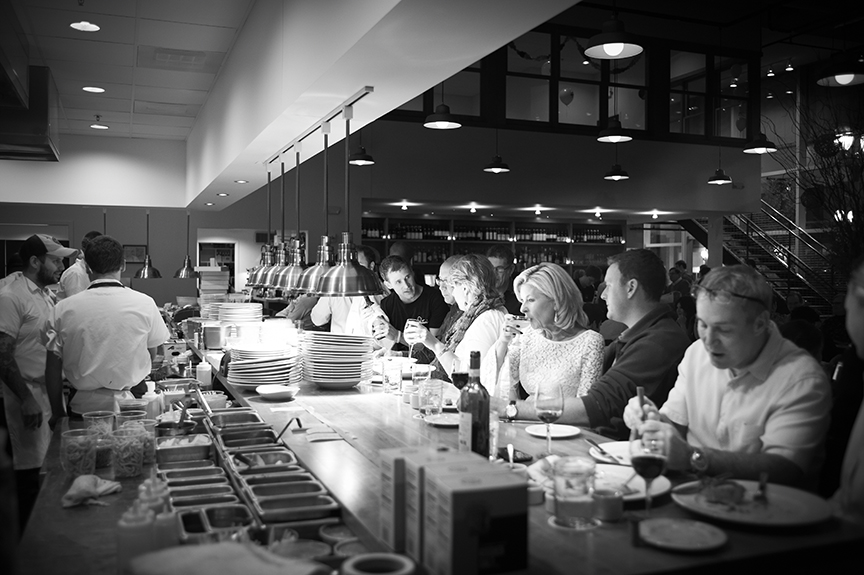
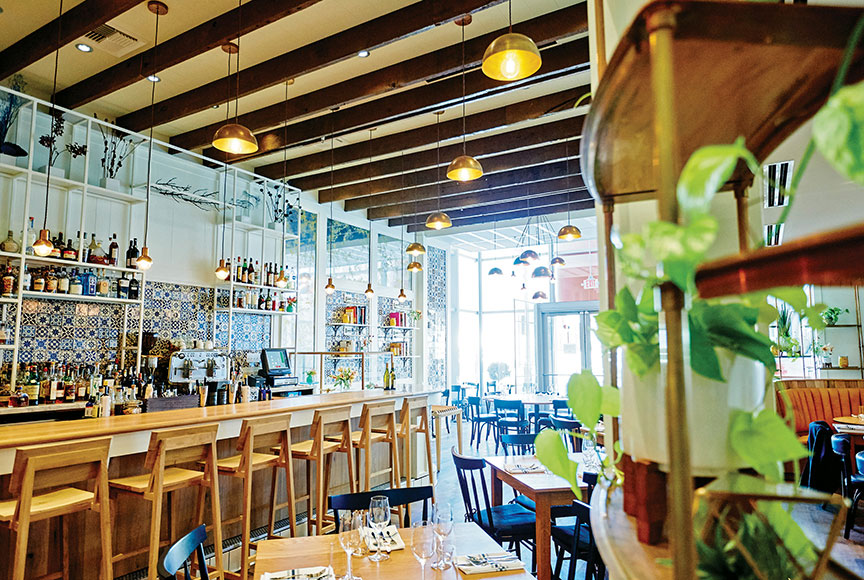
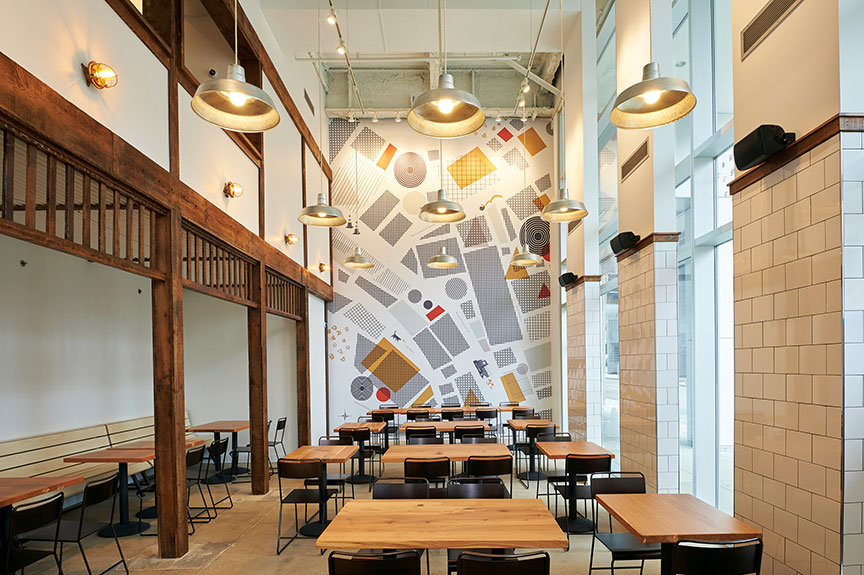
Niche was originally conceived as an unpretentious contemporary American restaurant, but an older clientele with fine dining expectations forced Craft to reinvent it as more of a special occasion restaurant. The servers, originally wearing tee-shirts, switched to collared shirts and pressed aprons, while the china was upgraded, explains Craft, who admits, “That slippery slope into fine dining pushed me to become a more creative and ambitious chef.”
Craft subsequently opened Brasserie by Niche, an authentic French bistro that reflects his love of Paris, Porano for quick-service Italian cooking, Pastaria for organic pastas, and mixology-driven Taste. While he acknowledges St. Louis lacks the wealth of dining found in its rival Midwestern city of Chicago, he contends, “There may not be a chic modern restaurant on every block, but the ones that succeed here are special.” In the pipeline for Craft is Pastaria Nashville, his first venture in neighboring Tennessee.
The James Beard Award-winning chef is perhaps the greatest single ambassador for Missouri-sourced ingredients. At the height of Craft’s commitment to local foods, 97 percent of the ingredients on Niche’s menu were produced in the Show Me State, including the onions going into stock for sauces, caviar from local rivers and even wine from Missouri vineyards. “It definitely generated a sense of pride in home-raised Missouri products,” says Craft. Insisting Missouri remains an unpretentious, approachable place, he suggests, “The hot summers and cold winters produce real people, and the vegetables are the same way, more humble and less precious.” Because of the movement that Craft spearheaded, there are now farmers and ranchers offering to grow vegetables or raise animals specifically for the needs of local chefs.
Craft shuttered Niche last year after a decade-long run, citing the intensity of maintaining standards at the city’s top-rated restaurant. “The competition begins to wear on you, and you begin to forget why you decided to cook in the first place,” says the chef, who converted the space into Sardella, a less expensive restaurant that celebrates his passion for Italian cooking.
A signature dish at Sardella is charred butternut squash with roasted garlic custard, Calabrian chile vinaigrette and basil that Craft describes as having bright flavors and a spicy, almost Thai-like quality even though all of the ingredients are Italian. “It’s an Italian dish that you’d never find in Italy,” quips the chef.
Gerard Craft and St. Louis have been good for one another, with the 37-year-old chef offering a diversity of local restaurants that may be the product of global influences but are true to their Missouri heritage.
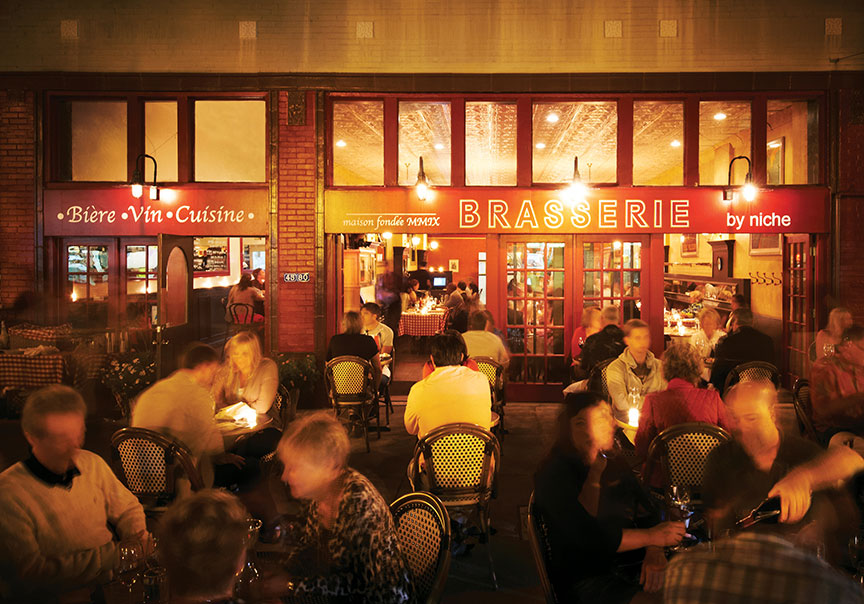
Photos courtesy of Greg Rannells


